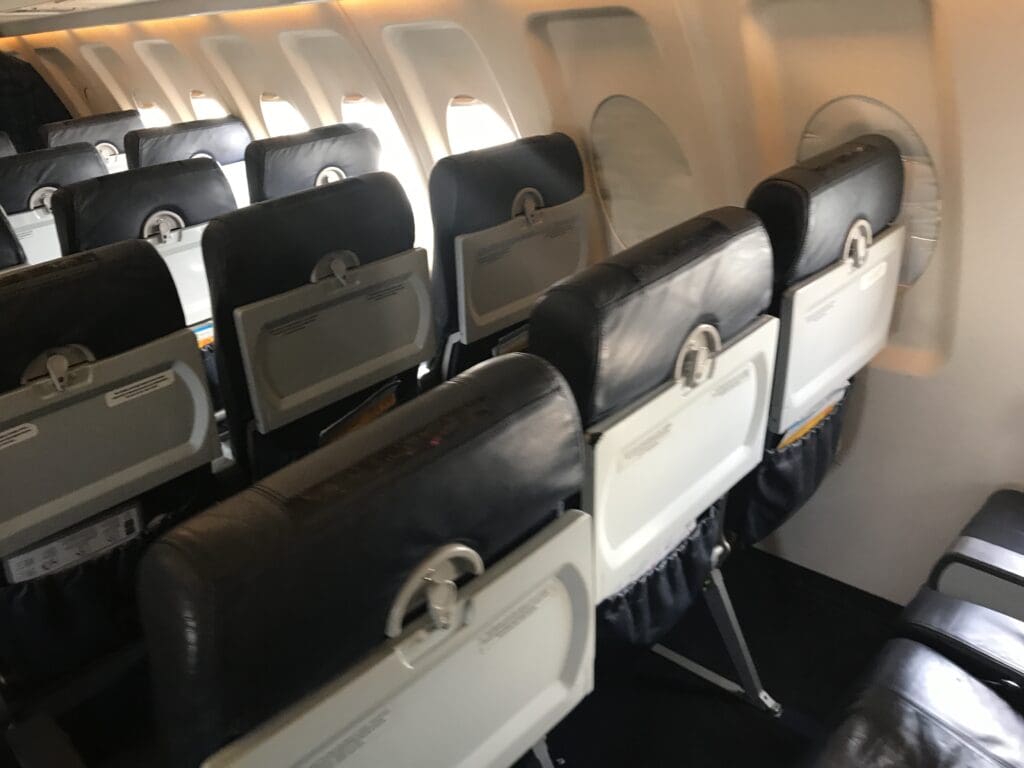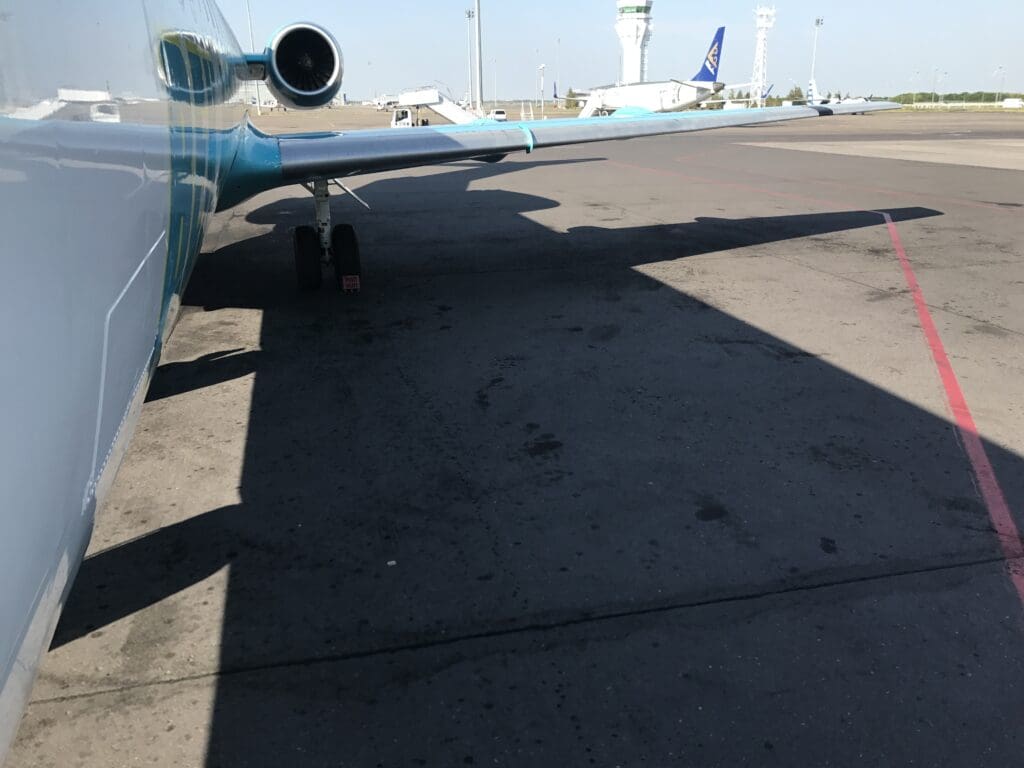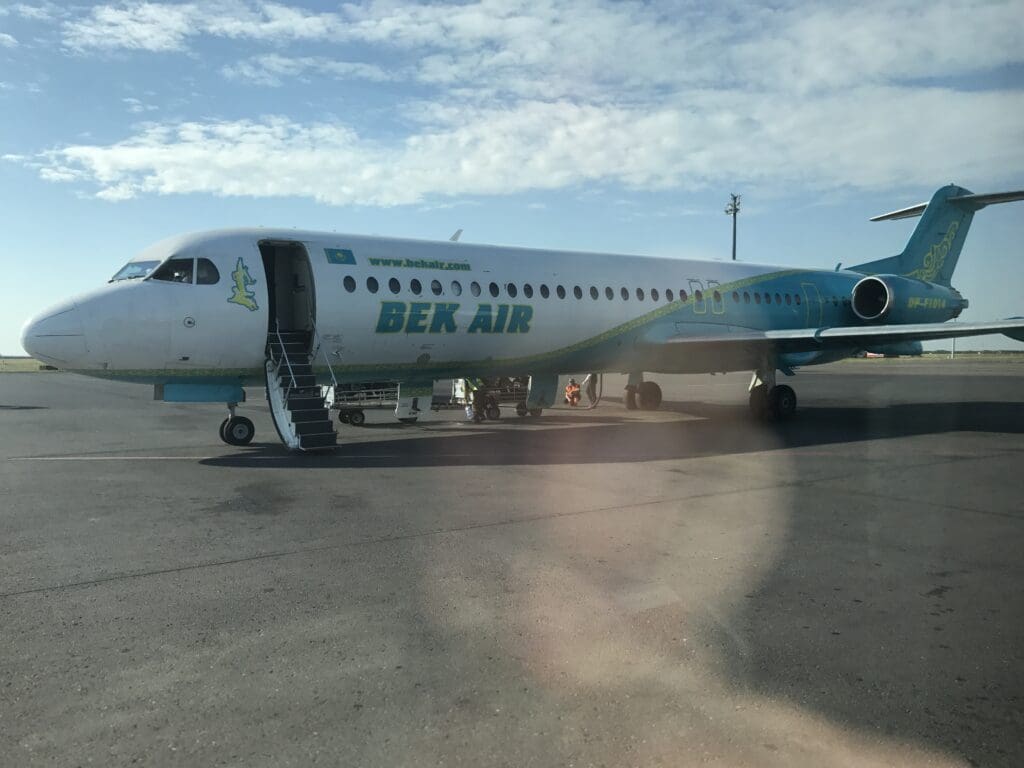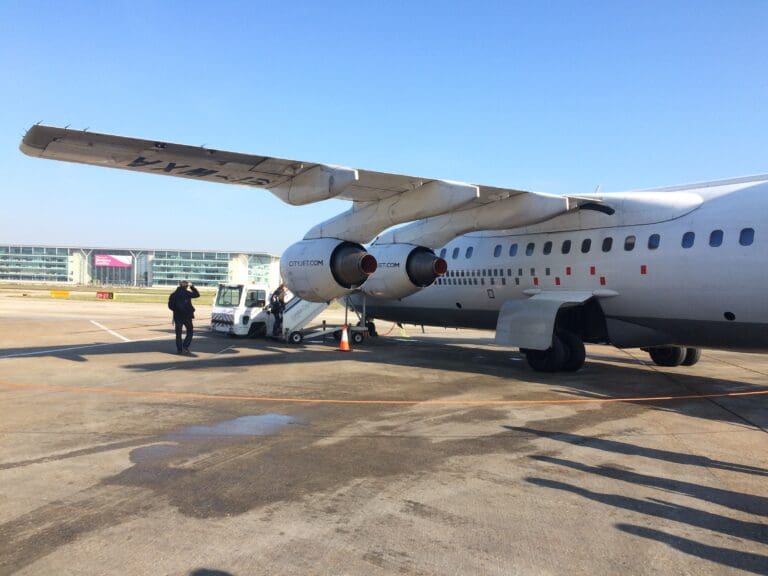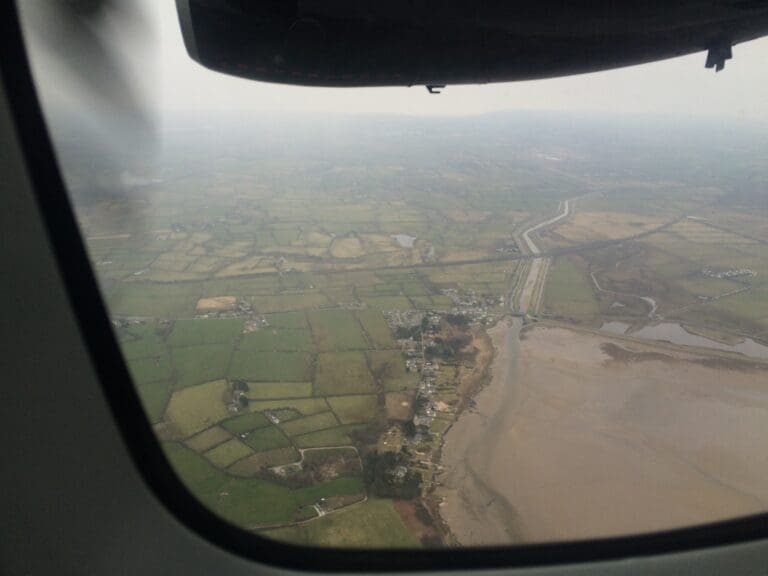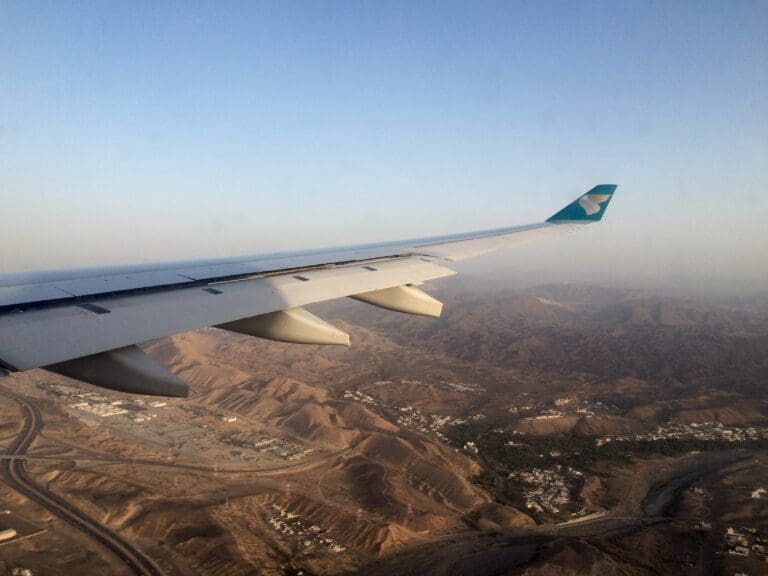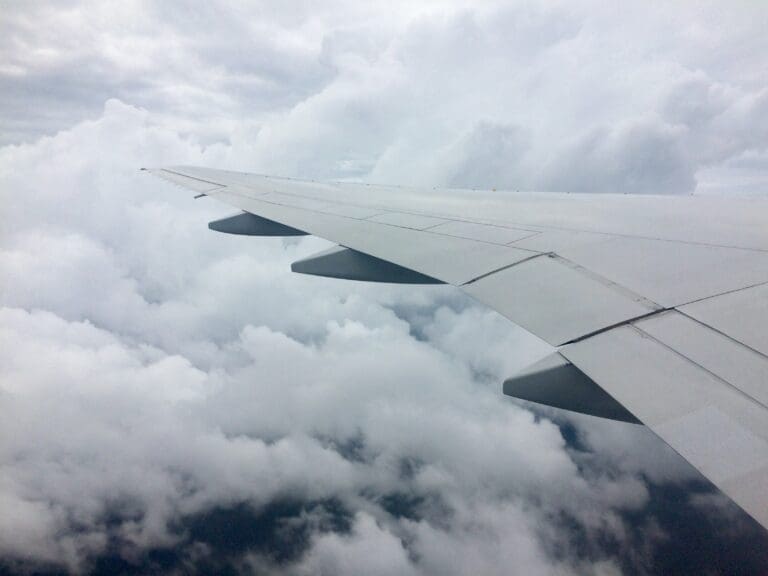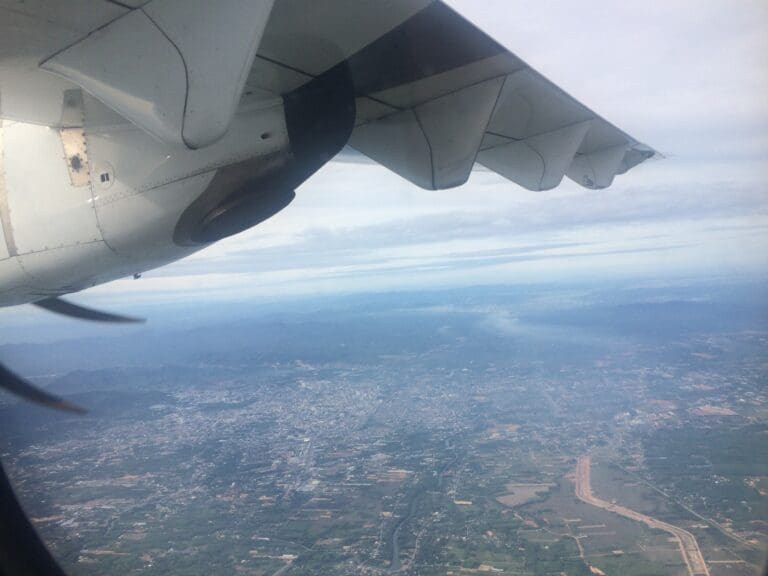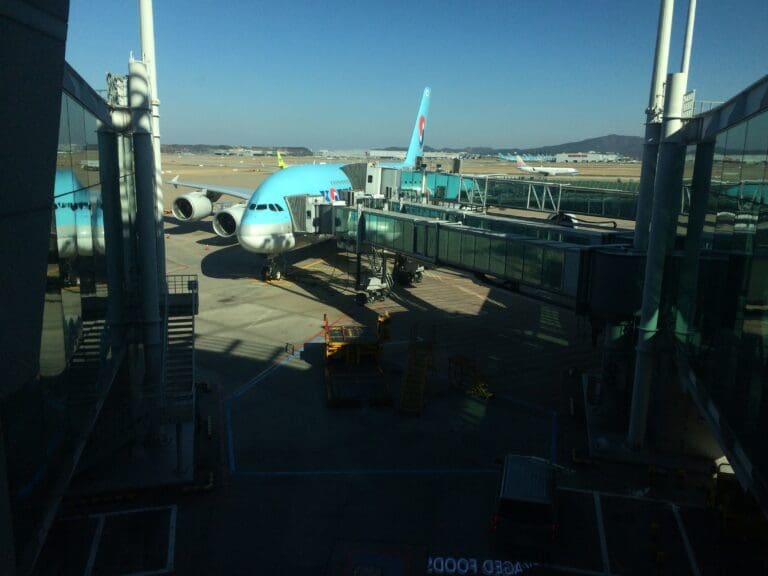Remembering Bek Air and Their Old Fokker 100: Almaty to Astana
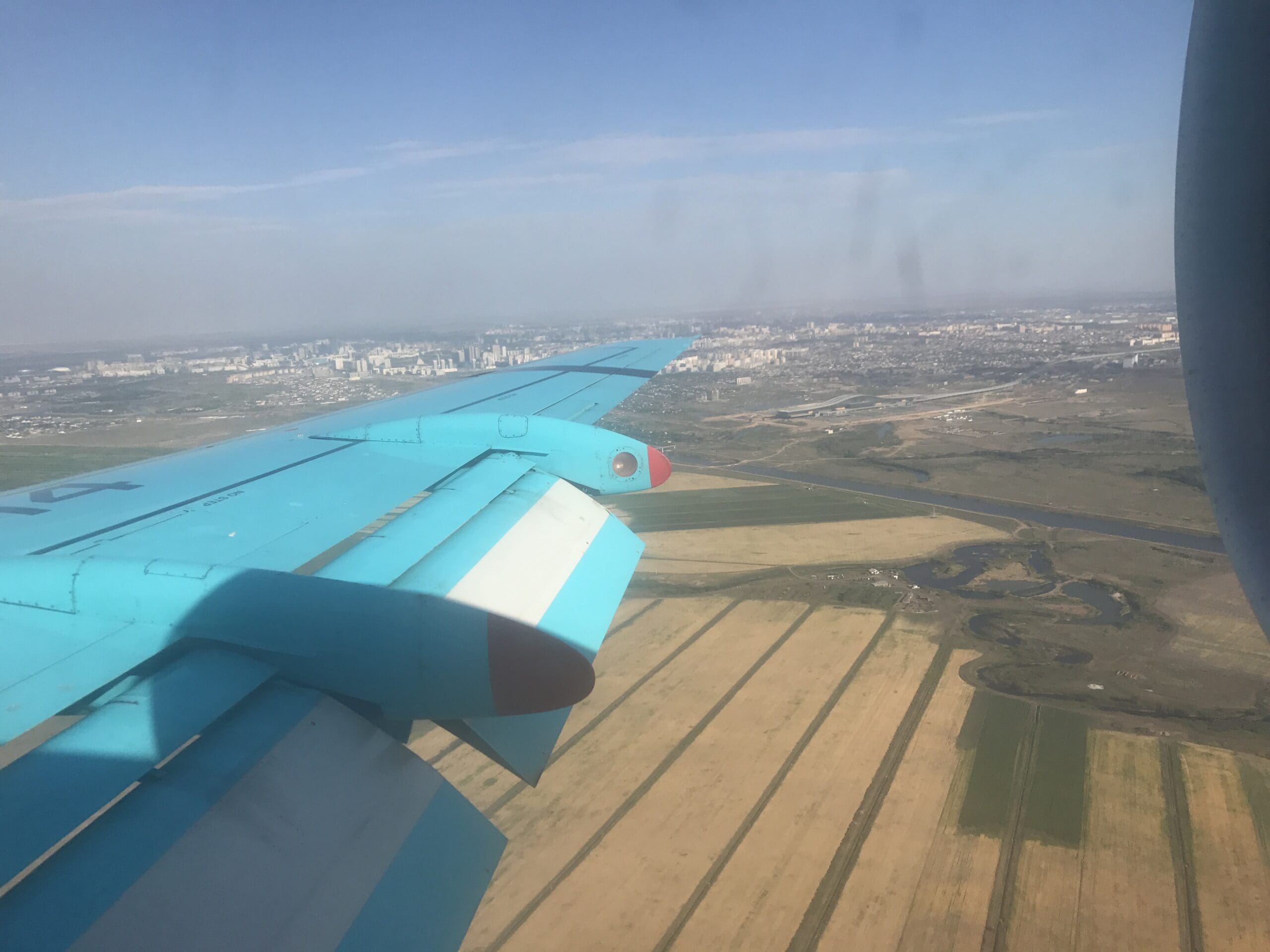
In December 2019, Bek Air Flight 2100, crashed as it attempted to depart Almaty on its way to Astana. During take-off, the Fokker 100’s tail struck the runway twice as the aircraft struggled to get airborne. Once in the skies, the aircraft failed to gain altitude and made contact with the concrete perimeter wall before crashing into a building. This sadly resulted in the deaths of 13 of the flight’s 98 occupants. The subsequent investigation attributed the accident to the pilots’ failure to adequately inspect the aircraft before departure, thereby failing to recognise the ice accumulation on the airframe that resulted in the aircraft’s struggle to take to the skies.
In the aftermath, Bek Air’s air operator’s certificate was immediately suspended, and soon, a catalogue of safety failings at the carrier were uncovered. These included pilots’ frequently neglecting to undertake walkarounds, failure to adhere to maintenance and operational manuals, and the unrecorded swapping of parts between aircraft alongside the removal of data plates from these ensuring that parts’ service history could not be accurately verified. As a result, in April 2020, the Aviation Administration of Kazakhstan permanently withdrew Bek Air’s air operator’s certificate and the airworthiness certifications of all aircraft in the airline’s fleet, resulting in the closure of the company. Whilst conscious that Bek Air had only been removed from the European Union’s Air Safety List nine months’ before my flight. Unaware of the scale of malpractice, in August 2017, I opted to fly with Bek Air between Almaty and Astana.
Background
Sitting in Kazakhstan’s southeastern corner near the border with both China and Kyrgyzstan, Almaty is the country’s largest city and is home to around 1.9 million residents. Throughout the Soviet era, Almaty served as the capital of Kazakhstan. However, in 1997, the government opted to shift power to the small city of Akmola in the north of the country, renaming this Astana, literally meaning ‘capital’. Today, Almaty and Astana are Kazakhstan’s two largest cities and thus unsurprisingly, there is no shortage of ways to travel between these. Every day, plenty of flights, train and bus services are offered between the two, however with buses taking around twenty hours to make this trip, and trains twelve hours, unsurprisingly flying is one of the more popular means to travel between Almaty and Astana.
At the time of my trip, four airlines operated direct flights between Kazakhstan’s two largest cities – Air Astana, Bek Air, Qazaq Air and SCAT Airlines, deploying types ranging in size from the small Dash 8 Q400 up to Kazakhstan’s largest passenger aircraft, the Boeing 767-300ER. Seeing as my trip to Kazakhstan had already involved rides on Qazaq Air and SCAT Airlines, and drawn in by the opportunity of flying the increasingly rare Fokker 100, needing to hop between Almaty and Astana, I decided to fly with Bek Air.
Headquartered in the city of Oral, known in Russian as Uralsk, in the far northwest of Kazakhstan, the chances are those outside of the country won’t be too familiar with Bek Air. Established in 1999 as Berkut Air, the company started by offering charter services, primarily in support of the local oil and gas industry. Throughout the next decade, the company operated an eclectic mix of interesting aircraft that included the BAC 1-11, Dassault Falcon 20, Tupolev Tu-154 and Yakovlev Yak-40. In 2011, Berkut Air decided to branch out into commercial scheduled passenger operations and rebranded to Bek Air, with ‘Bek’ meaning chieftain or leader, a figure depicted on the airline’s logo. A fleet of Fokker 100s was selected to drive this new operating model, with these becoming the sole aircraft type in Bek Air’s fleet, whilst the airline built up a fairly extensive domestic route network. In addition to this, the airline also wet-leased aircraft to Afghan carriers Kam Air and Safi Airways.
Booking and Online Check-In
Despite the fact that Bek Air’s route network did not extend beyond the borders of Kazakhstan, just like competitors Qazaq Air and SCAT Airlines, I found the airline’s website to be available in English alongside Kazakh and Russian. This was modern, easy to navigate and home to all the information that you would expect to find on an airline’s website, plus a short history of the Fokker 100. Soon, I went ahead and undertook a quick search for flights between Almaty and Astana on my chosen departure day, before being presented with a morning and an afternoon flight.
Seeing as I was staying in a hotel on the airport grounds and sought to have a look around Kazakhstan’s capital city after my arrival, I opted for the cheaper morning departure. Upon selecting this flight I was presented with the option of selecting a seat in the first two rows for the reasonable sum of 4,000 Kazakh Tenge (£8.50/€9.50). Assuming these were just regular economy seats at the front of the cabin, I was later surprised to see that these were traditional large business class seats in a 2-2 configuration. Whilst Bek Air did offer a 15kg complimentary luggage allowance for all tickets, I was also given the option of paying a nominal fee to top this up. However, concluding this to be unnecessary, I steamed onwards and headed straight to the payment page. Fortunately, I was able to make payment without any problems, with this coming to a grand total of just under 20,000 Tenge (around £36).
As with many airlines, Bek Air offered an online check-in service which opened 24 hours prior to departure. Hoping to select my seat, I was pleased to find that this was a quick and easy process, enabling me to pick my seat without any additional payment. Doing so early on within this window, I ended up with the sequence number of ‘001’.
The Flight
Ten days after purchasing my ticket for the Fokker flight up to Almaty, departure day rolled around. Following a pleasant couple of days in Almaty, I lugged my luggage into the Aksuntar Airport Hotel’s small and rickety lift before heading out into the morning darkness. As far as airport hotels go, I found this hotel to be somewhat basic and seemed to have undergone little renovation over the years. However, having paid less than £20 per night and with this located a very short distance away from the terminal, I was unable to make any valid complaint about this hotel. Following a quick and cold communal shower, I darted out into the pleasantly cool morning air and followed the sparkling diamond which rests on top of the terminal building. A few minutes later, I arrived at the terminal’s busy entrance where passengers could be seen shuttling large amounts of luggage in between cars and the entrance doors.
As is often the case across much of the former Soviet Union, all passengers must pass through a brief security check before being allowed to enter the terminal. Fortunately, whilst the queue for this was by no means short, the line was orderly and moved along quickly. Once inside the warm terminal, I made my way up the escalators and arrived at the packed departures level where almost no empty seats could be seen. With no reason to remain landside in this rather crowded portion of the terminal, once there I made my way to the far end of the terminal which is home to the small square-shaped domestic check-in area.
Given the sheer number of passengers that morning, once in the check-in hall I expected to be greeted by the sight of long queues, however, I was pleasantly surprised to see that, unlike the other desks, those of Bek Air were totally devoid of passengers and I was thus able to walk straight up to one of the two Bek Air desks. Once there I was greeted in Russian by the check-in agent who sported casual clothes albeit with an Almaty Airport branded lanyard that served to prove their status as an airport employee. As soon as I placed my bag on the belt, I noticed that thanks to all of the souvenirs that I had picked up in Almaty, this was a kilogram over Bek Air’s basic hold luggage allowance. Fortunately, the airport worker seemed not to care and soon tagged my suitcase before sending this off on its way and handing me a plain boarding pass. Next up was security, where, despite the lack of checkpoints, the efficient staff members meant that the short queue there shuffled along quickly and I was soon able to enter the airside area.
Once through security, I found the large departure hall that passengers immediately enter after this was rather busy, with almost no seats remaining available. I therefore decided to head over the glass bridge and set up camp in the smaller yet quieter waiting area which sits above the domestic arrivals area. From there, a relatively good view of the apron could be had thanks to the large glass windows. Whilst this may seem ideal for those enthusiasts looking to get some good shots of aircraft, unfortunately, large signs advise passengers not to take photographs (these have since been removed). Outside, one of Air Astana’s Boeing 767-300ERs could be seen connected to one of the airport’s few jetbridges. This particular aircraft had arrived from Seoul Incheon the previous evening and was, like me, set to head off to Astana. Meanwhile, the international contingent consisted of a selection of narrowbody aircraft including Airbus A321s from Aeroflot and Atlasjet that had arrived after overnight flights from Moscow and Istanbul respectively, as well as a Boeing 737-800 from Turkish Airlines. These were later joined by a Hong Kong Airlines Airbus A330 Freighter that popped in for fuel on its journey between Hong Kong and Istanbul. Aside from these, a selection of business jets and an interesting mixture of mostly government and military Soviet-built aircraft, both active and stored, could be seen in the distance.
Once passengers bound for Oskemen on Air Astana’s morning Embraer 190 operated service, the waiting area quietened down a little however it wasn’t long before these passengers were replaced by those heading off on Bek Air’s 0700 service to Astana. Looking outside, I was offered a great view of the rather battered and weathered yet colourful Bek Air Fokker 100 that would be taking us up to Astana. This took the form of UP-F1014, Bek Air’s then-oldest aircraft.
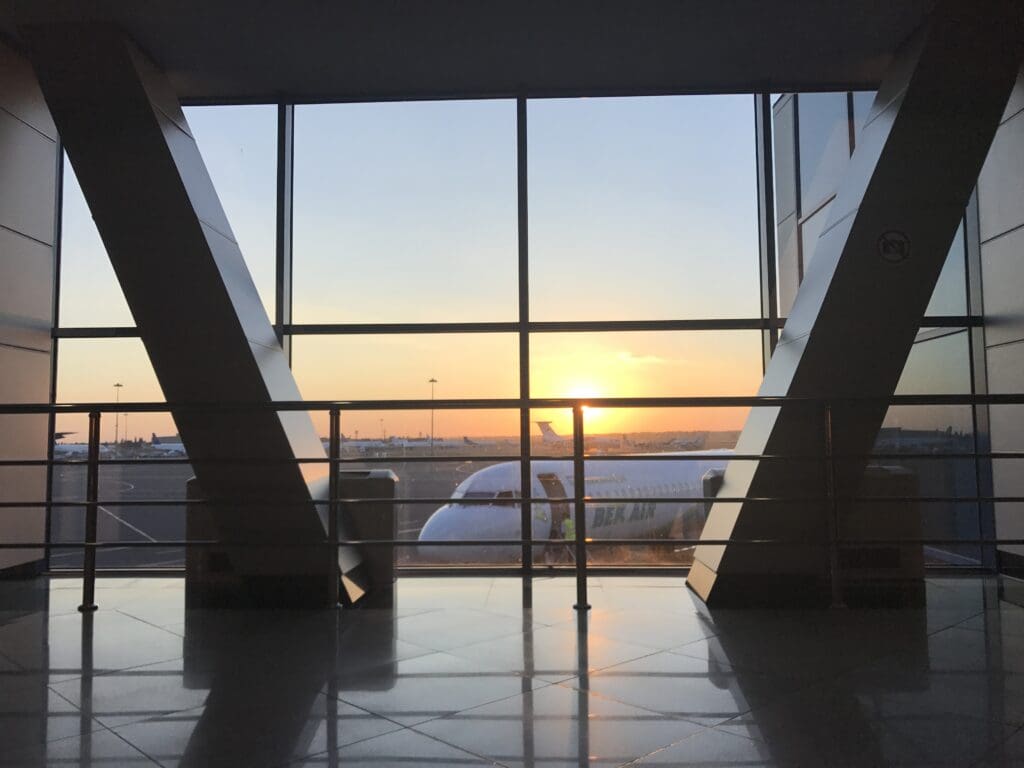
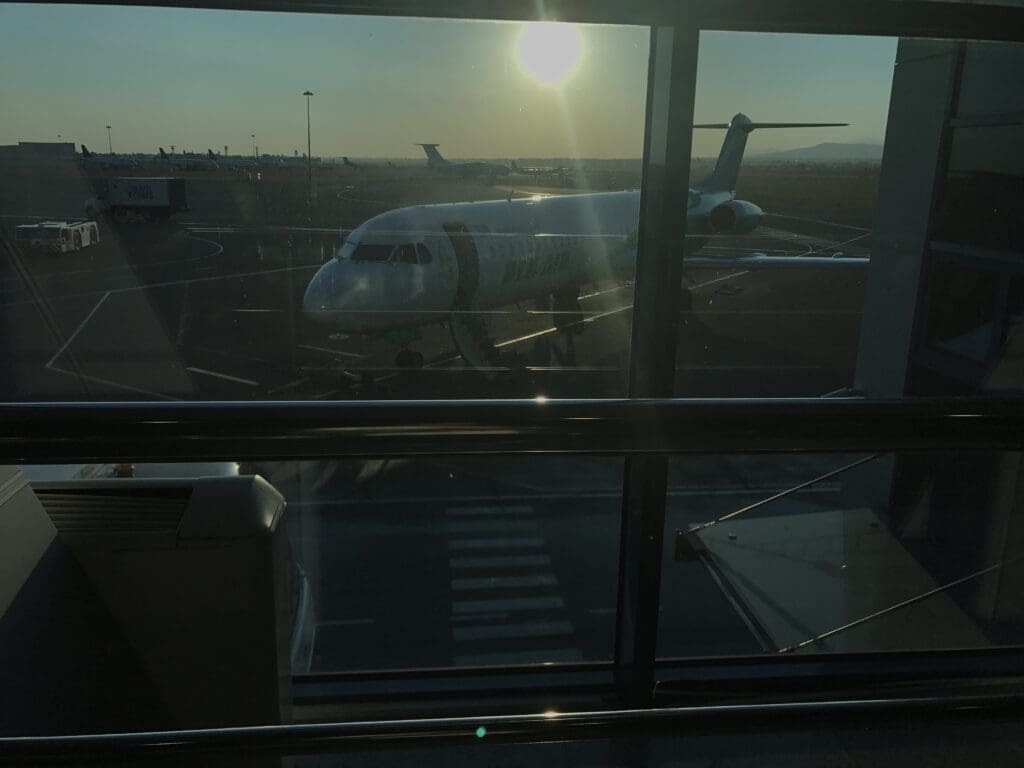
With a diverse history, even before the airframe had even made its first flight, this aircraft found itself being tossed around Fokker’s order books. This particular example had initially been ordered in 1988 by the second ill-fated reincarnation of Braniff. The collapse of this carrier the following year set the aircraft on course to be received by Pan Am, however, this order was never taken up and instead by the time the aircraft neared completion, the aircraft was intended to be delivered to Iran Air. In April 1991, the aircraft made its first flight from Fokker’s Schiphol factory and two months later, instead of flying east to Iran, the aircraft flew southwest across the Atlantic to Brazil, finding a home with TAM. Following thirteen years in the skies of South America, the aircraft was flown back across the Atlantic, settling in Spain. Here, from 2004 to 2008, the aircraft was operated by Girjet on behalf of Spanair on their services across Europe. After this spell in Spain, the aircraft returned to its homeland where it was re-registered as PH-LNE and commenced flying with the now-defunct Denim Air. During this time, the aircraft operated services for short-lived airlines Sirocco Aviation and Excellent Air.
In March 2013, the aircraft entered storage in Saarbrücken, however, ten months later, the aircraft was painted in the Bek Air livery and was flown across to Kazakhstan. Since its delivery to the airline, aside from simply operating domestic services with Bek Air, the aircraft also spent prolonged periods flying in Afghanistan on behalf of both Kam Air and Safi Airways. In fact, the aircraft returned from the latest of these deployments just a week before my flight. However, wasting no time in placing the aircraft back into service in Kazakhstan, in the week before my flight, the aircraft had flown 28 flights across Kazakhstan covering around 19,600 miles and visiting Aktau, Aktobe, Almaty, Astana, Atyrau, Kyzylorda and Shymkent.
At 0600, the flight’s three flight attendants arrived at the steps of the Fokker and soon got to work, assisting the ground team with the loading of the service carts – with these being carried by hand up the aircraft’s steps. Once the carts had been loaded, a team of cleaners emerged from the jet, with the last cleaner paying great attention to detail, polishing each step one by one as they disembarked. Several minutes later, the flight’s two pilots arrived at the jet, both shaking hands with one of the ground engineers before heading into the aircraft and disappearing into the cockpit. At 0630, an announcement was made in Kazakh, Russian and English, inviting all passengers to board the aircraft, with this being done in no particular order. Unlike my previous flights in Kazakhstan, that morning a crowd formed as opposed to an orderly queue. After a few minutes in this scrum, my boarding pass was scanned before I headed down the stairs and out into the cool morning air. Once outside, I was required to wait at the aircraft’s steps, however, given the great weather, and the fact that this wait allowed for good views of the rare jet and the snow-capped Trans-Ile mountains in the distance, I could not complain about this short pause!
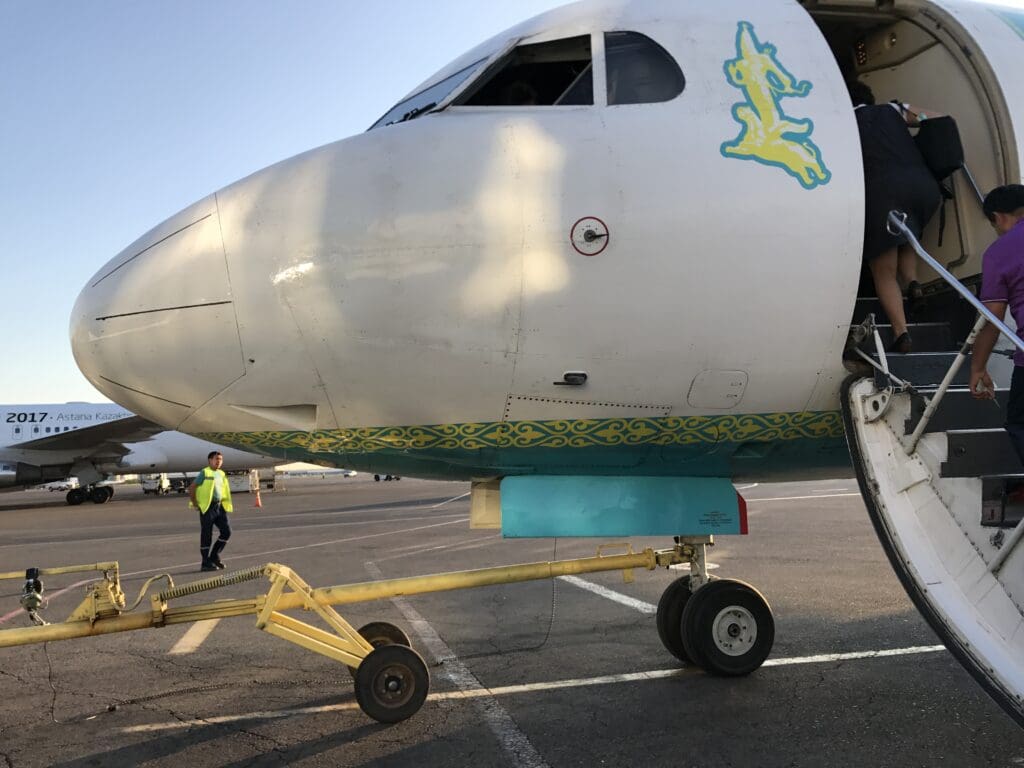
After a couple of minutes or so, I was permitted to head up into the aircraft, and soon made my way up the steep steps built into the inner side of the Fokker’s sole passenger door. Once I entered the small forward galley, I was given a friendly welcome in Russian before turning right and entering the cabin. Seeing as there are few English language reviews of Bek Air, I wasn’t totally sure of what to expect onboard. However, given Bek Air’s lack of a business class product, I was a little surprised to find two rows of comfortable-looking leather-covered recliners in a 2-2 configuration. With these seats only costing an additional 4,000 Tenge to reserve, these seemed to be of rather good value although, of course, no extra service is offered. After passing these two rows, I then entered the main Economy cabin which was home to a total of 94 seats. Having seen Bek Air’s official photos of their aircraft’s cabins complete with comfortable modern leather seats, I had sort of expected these to be present on this aircraft, however, I was instead greeted by the sight of older-style seats covered in dark blue (faux?) leather covers. Having been one of the first passengers to board, I was able to head down the aircraft without stopping and I soon reached my seat opposite the aircraft’s rear exit. Perhaps somewhat worryingly, this was covered in stickers highlighting that this had been deactivated and thus could no longer be used to escape the aircraft in an emergency.
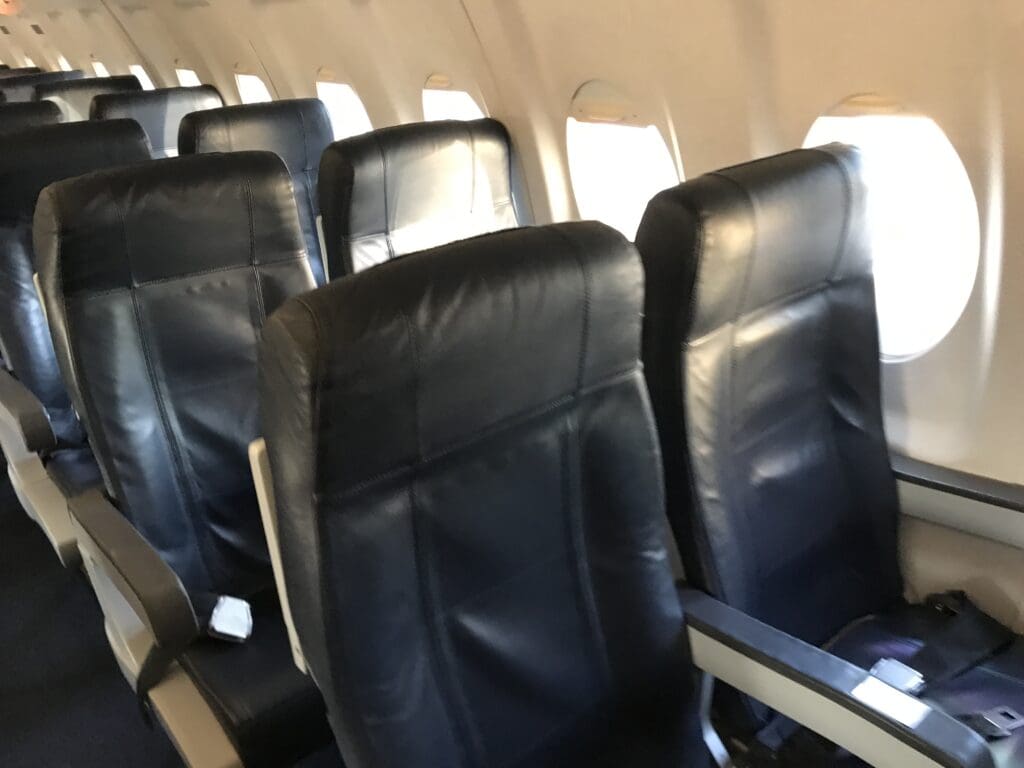
Once seated and settled, I was pleased to find that the seats were soft and comfortable, although they were rather cramped and far from the most spacious seats that I have had the pleasure of sitting in. Whilst this may have proven to be an issue for those on long three-hour slogs to the likes of Aktau or Oral on the other side of Kazakhstan, this was not a major issue on the 591-mile hop up to Astana. Turning to the seatback pocket, this contained a sick bag and a safety card. Interestingly, the latter referred to the aircraft as a Fokker F28 Mk0100 – a name that had not been used for the Fokker 100 since the early days of the type’s development! Looking around, I was pleasantly surprised to find that only a few marks and scratches could be seen in the area around my seat. That said, I noticed that the window was incredibly scratched and therefore any decent photography through this proved to be quite a challenge. Whilst most other passengers’ windows featured a plastic Fokker 100 branded window shade, mine lacked this luxury, instead, this consisted of a piece of white card that failed to stay in position when extended. Finally, as I had expected having witnessed the cleaning team exiting the aircraft, the cabin appeared to be immaculately clean and tidy.
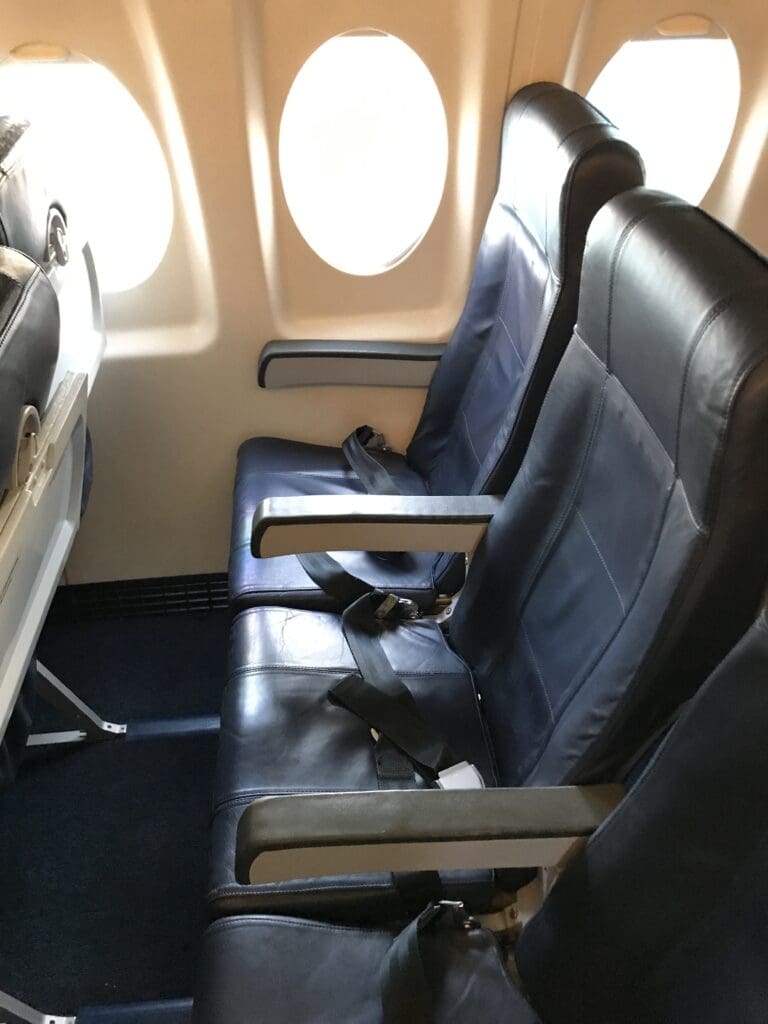
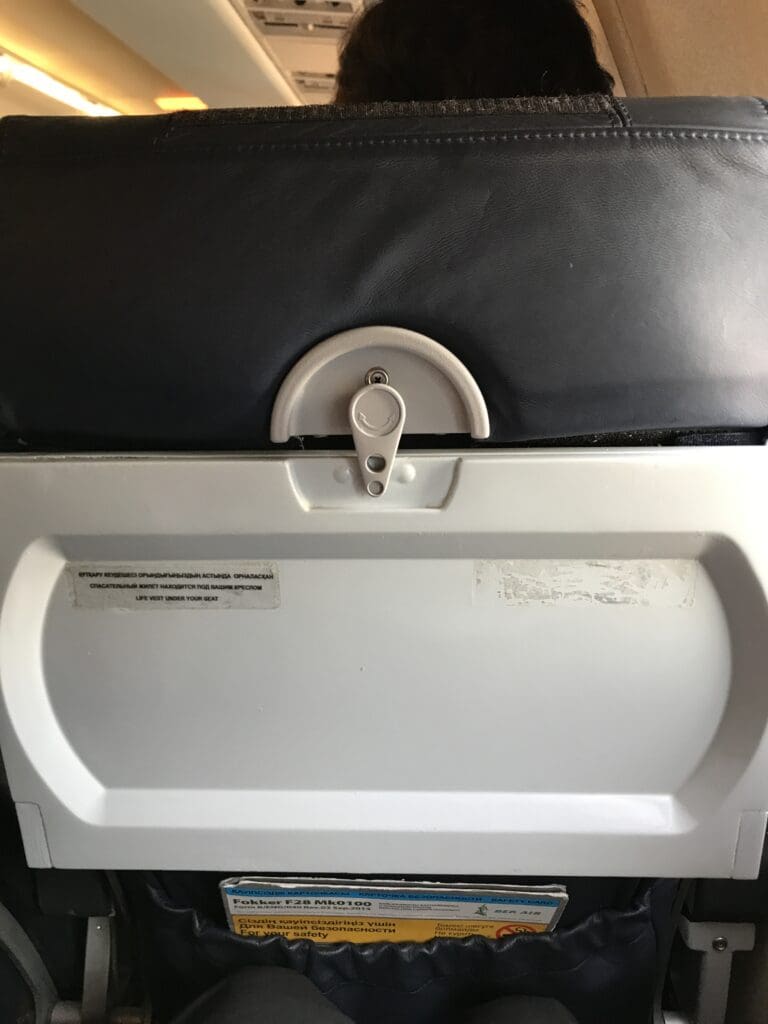
Even though many passengers were travelling with heaps of luggage, boarding was fairly quick, with all passengers making it onboard in about fifteen minutes. Unsurprisingly with this being a morning service between Kazakhstan’s two largest and most important cities, the aircraft was full. Turning to my fellow flyers, these seem to consist of a wide spectrum of passengers, young and old, including smartly dressed business people, tourists and families. Whilst most hailed from Kazakhstan, I also noticed passengers from China, Russia and Turkmenistan.
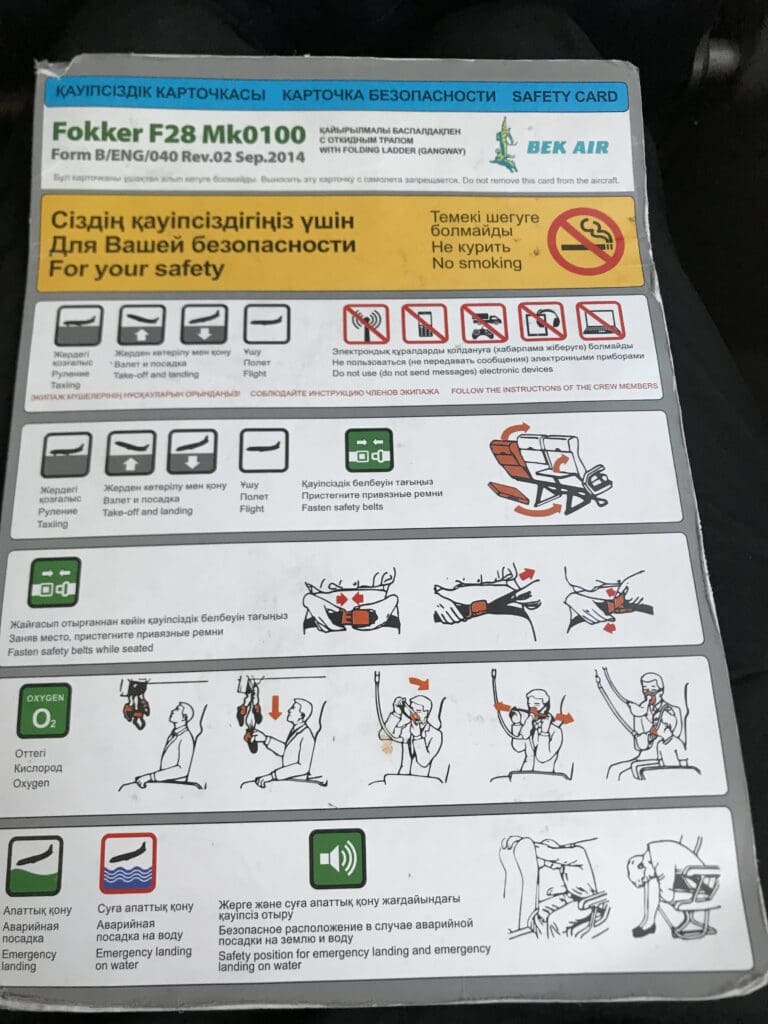
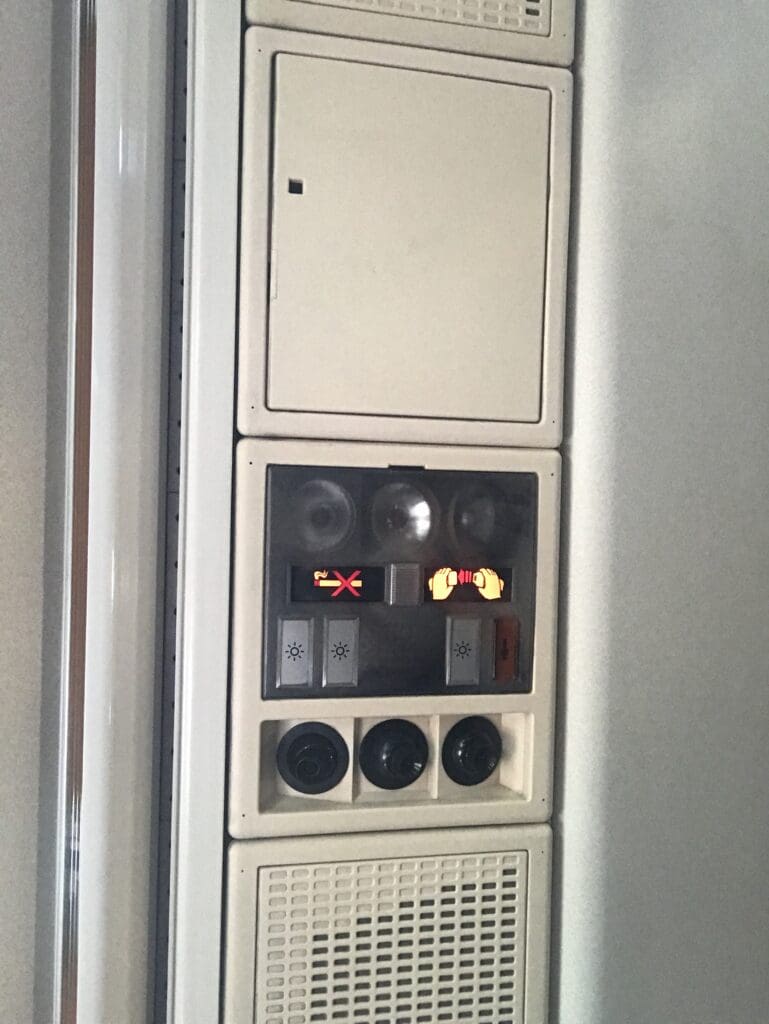
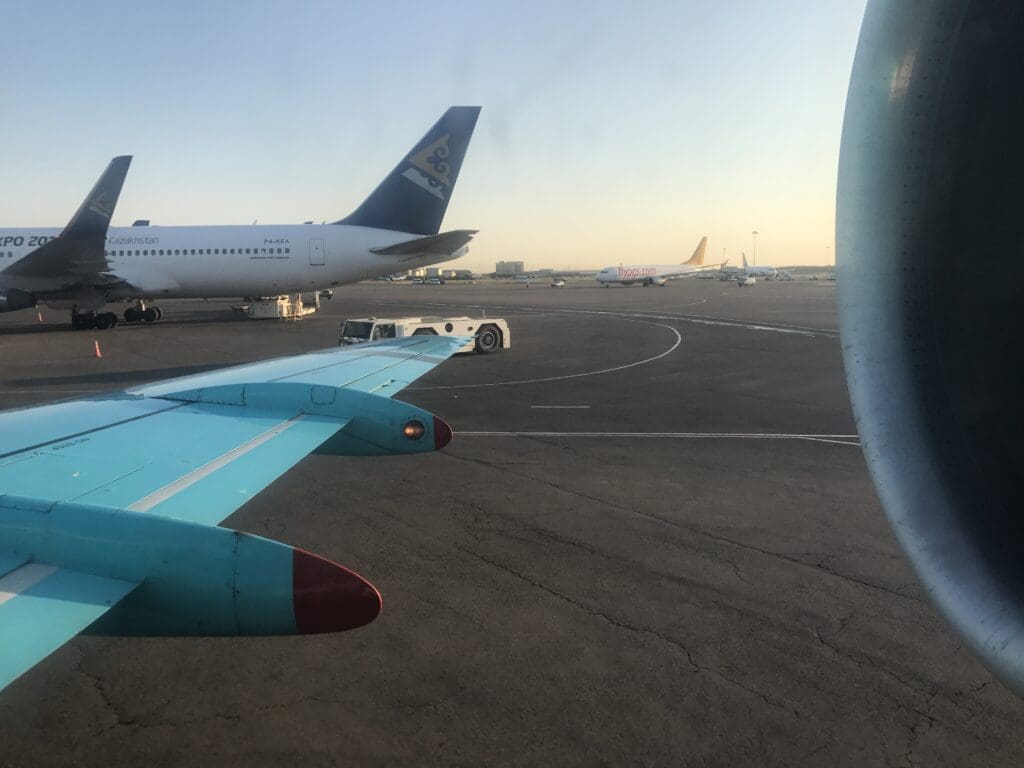
With ten minutes to go until the flight was scheduled to depart, the cabin door was closed at which point the Purser commenced their welcome announcement in Kazakh, Russian and English, which soon transformed into the safety demonstration. This consisted of the Purser reading through the safety instructions whilst a demonstration was undertaken in the aisle. As the safety instructions neared its end, a little ahead of schedule, the Fokker 100 jolted backwards, indicating that we were all ready to go. However, to my surprise, we were instead towed to a remote parking position next to Turkish Airlines’ Istanbul-bound Boeing 737-800. There, the aircraft waited for several minutes, whilst inside the cabin a flight attendant made their way through this with a basket of boiled sweets, distributing these to passengers whilst ensuring that all was secure and in place for our departure. After a few minutes, the noisy whine of the aircraft’s Rolls Royce Tay 650-15 consumed the rear portion of the cabin as these were fired up in preparation for our journey up to the capital city. Once these had spooled up, the flaps were partially extended before we powered forwards out of the stand and commenced a short taxi over to Runway 05L.
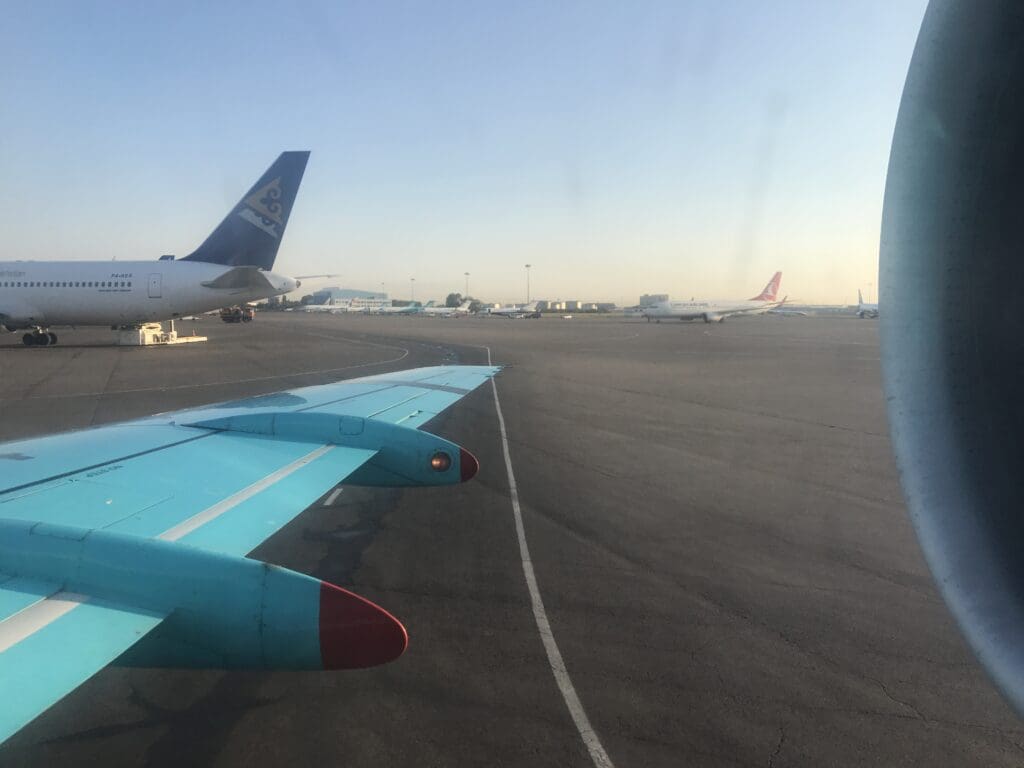
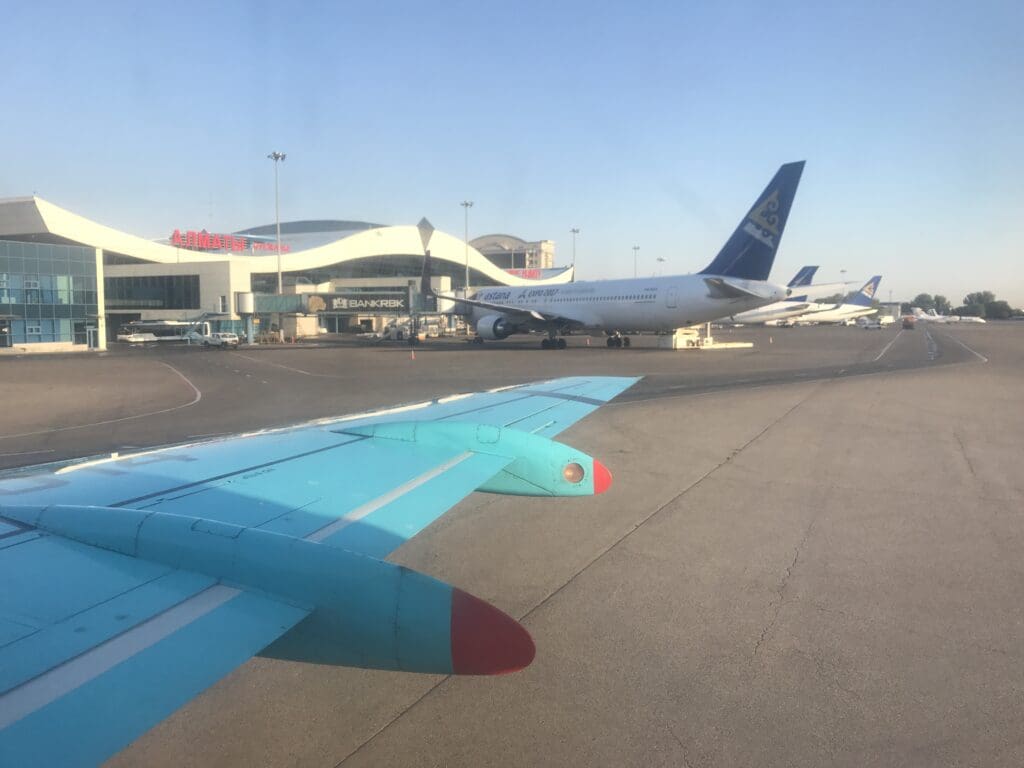
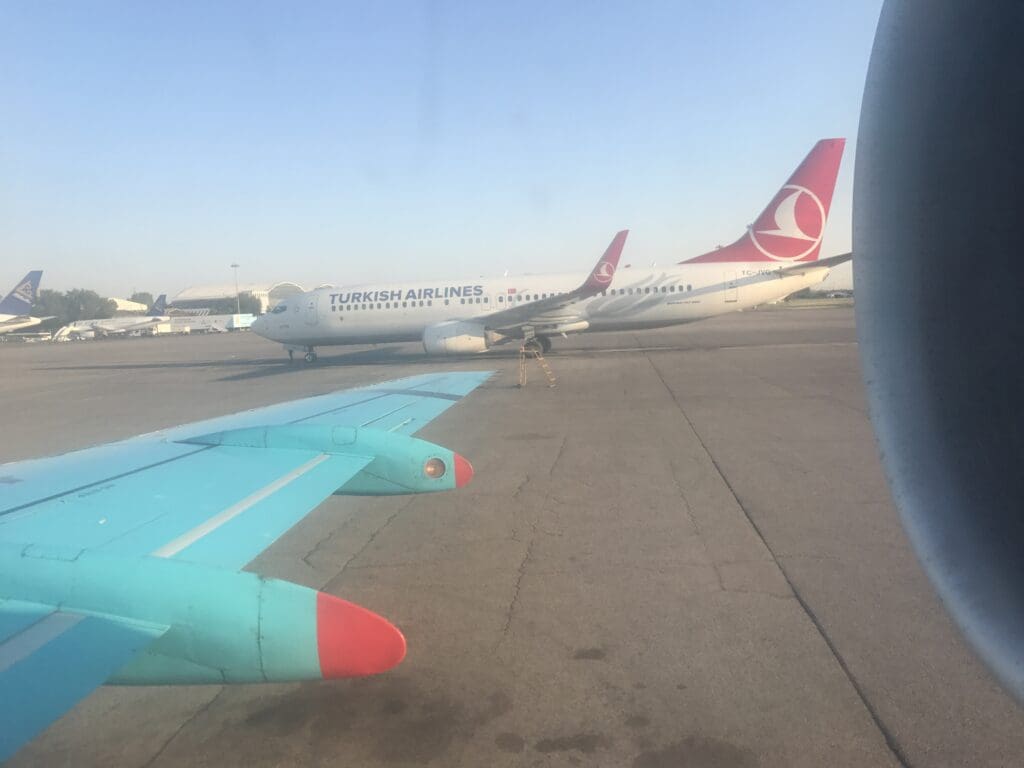
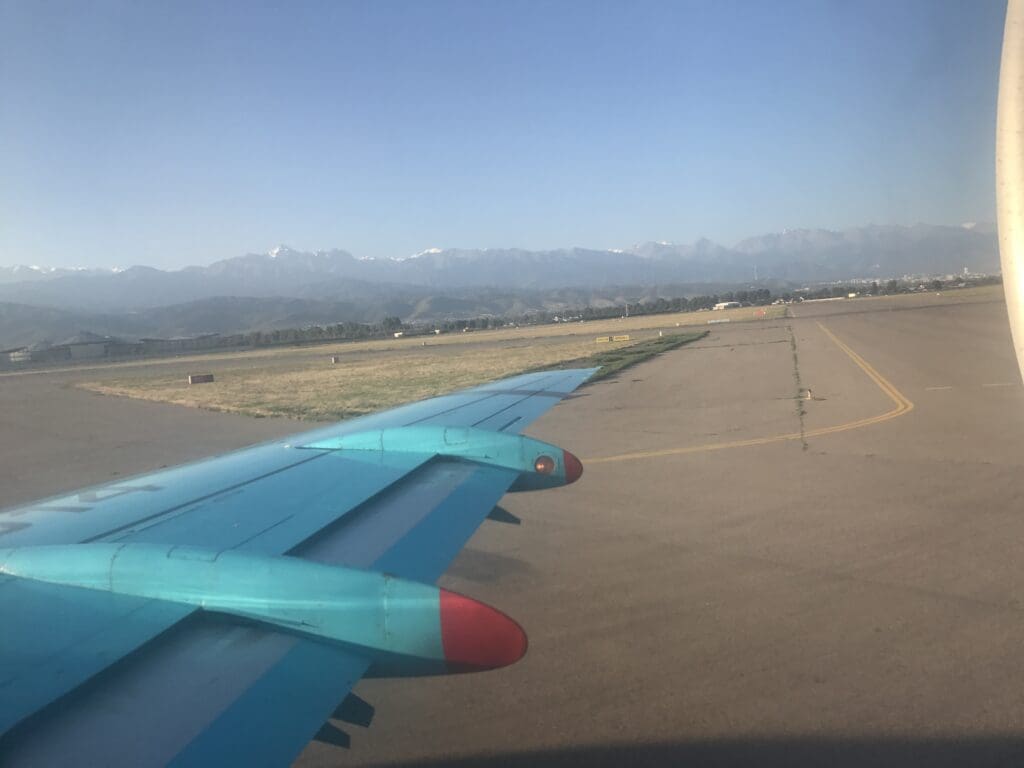
During the journey to the runway, the Fokker passed the airport’s respectable array of locally based and visiting business jets before coming to a halt at the end of the runway. Once there, the aircraft waited for several minutes to allow for a Sunday Airlines Boeing 757-200 to land at the end of a long overnight slog from Antalya before this backtracked down the runway. Eventually, at 0704, the Fokker made its way onto the runway and without pausing, the aircraft before a noisy and bumpy rolling take-off. Making what seemed to be a long take-off roll, the Fokker gently rotated into the sunny skies of Kazakhstan and made a shallow initial climb, soon turning onto a northwesterly leading that would put us on course for Astana.
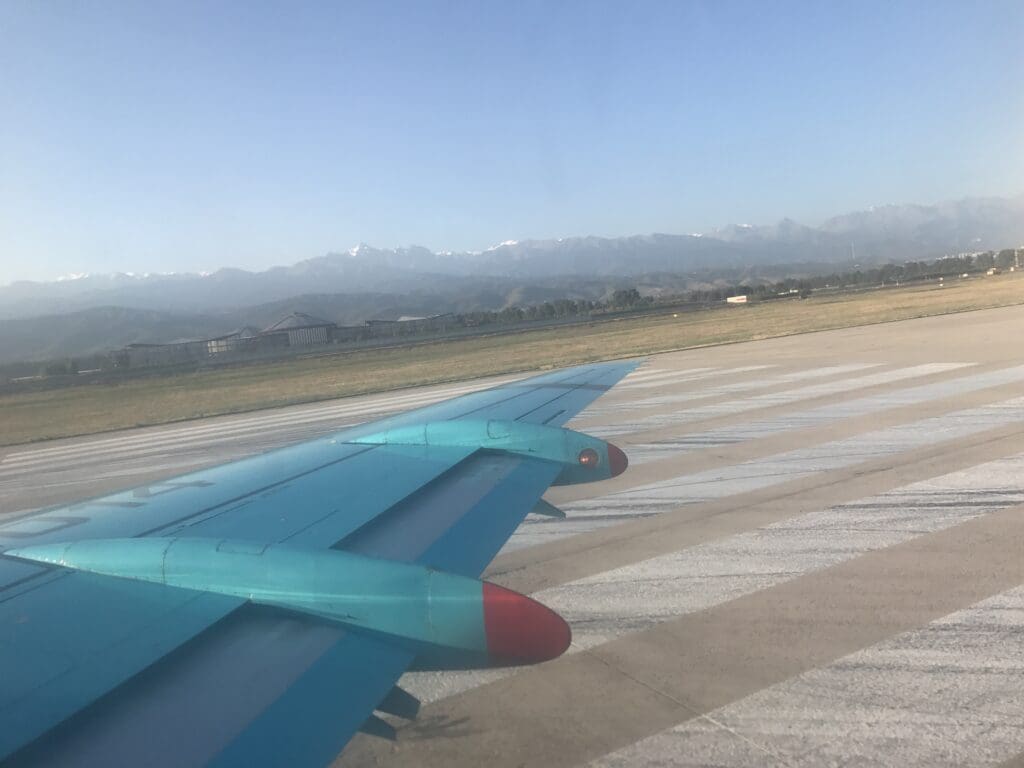
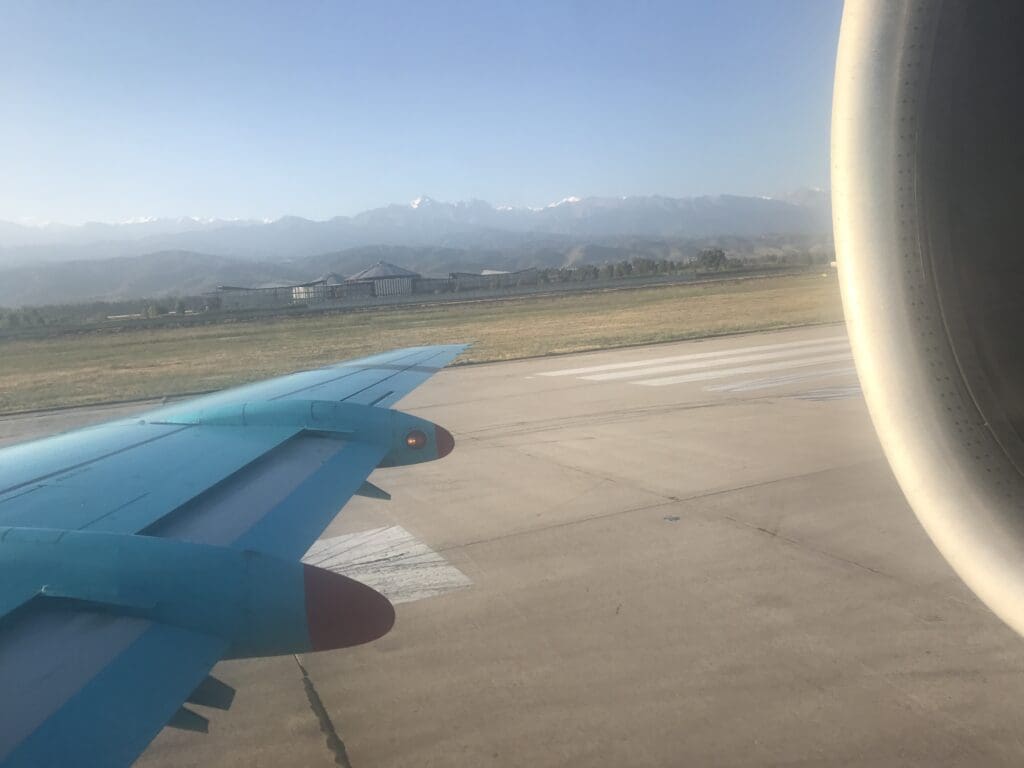
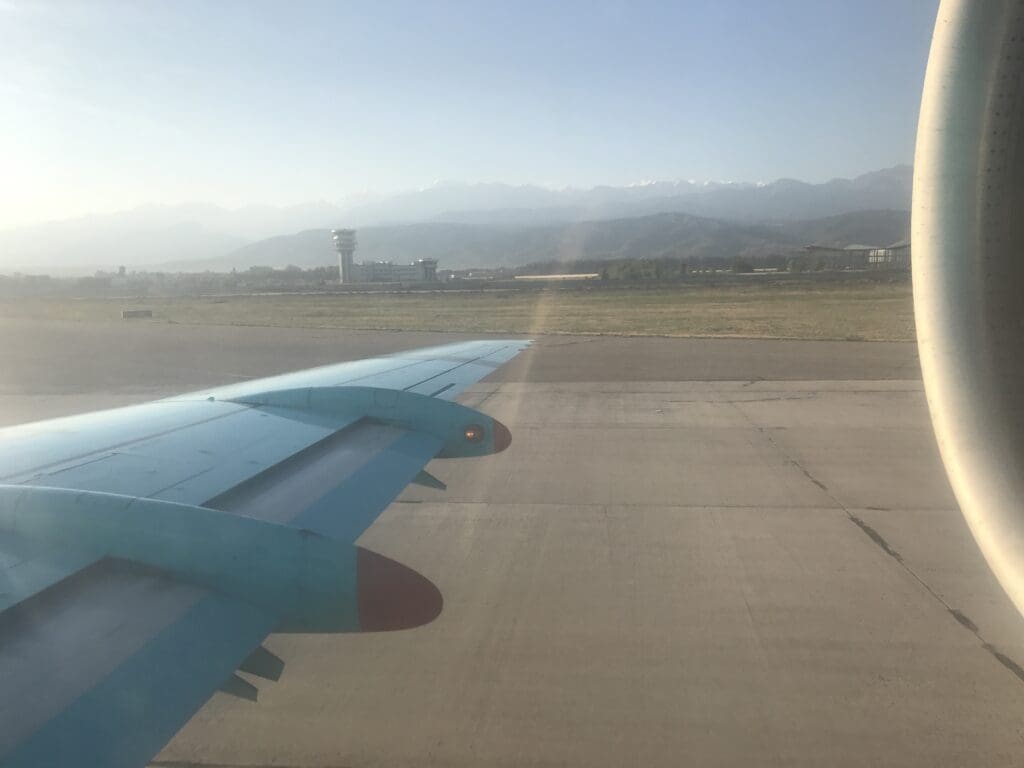
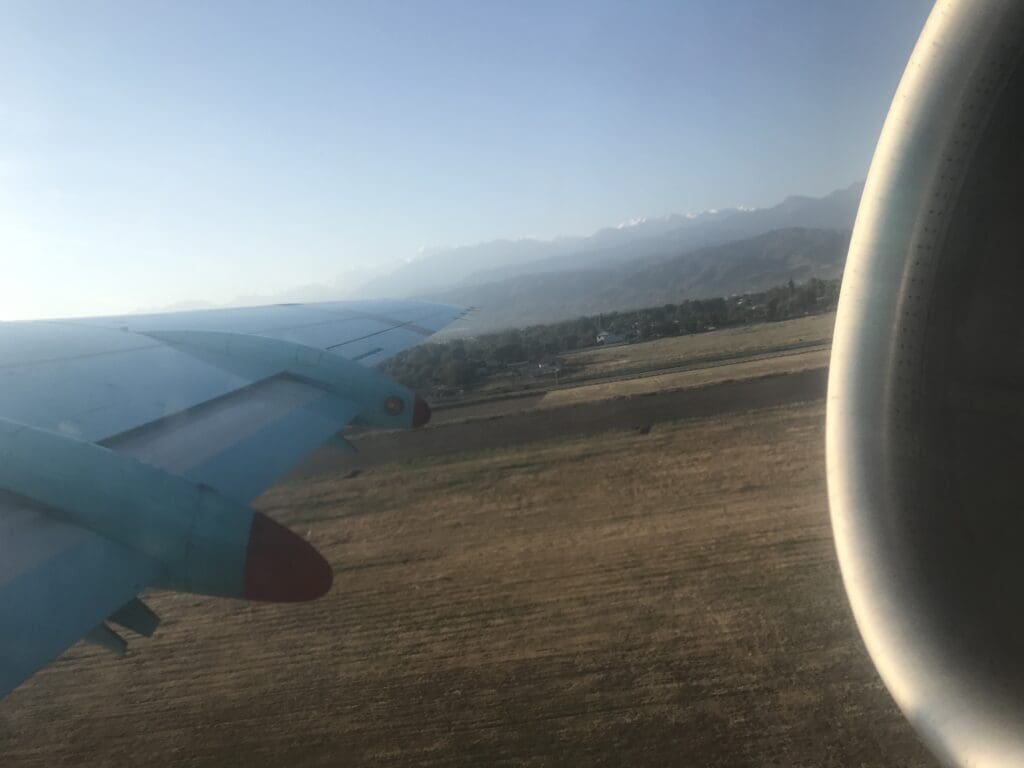
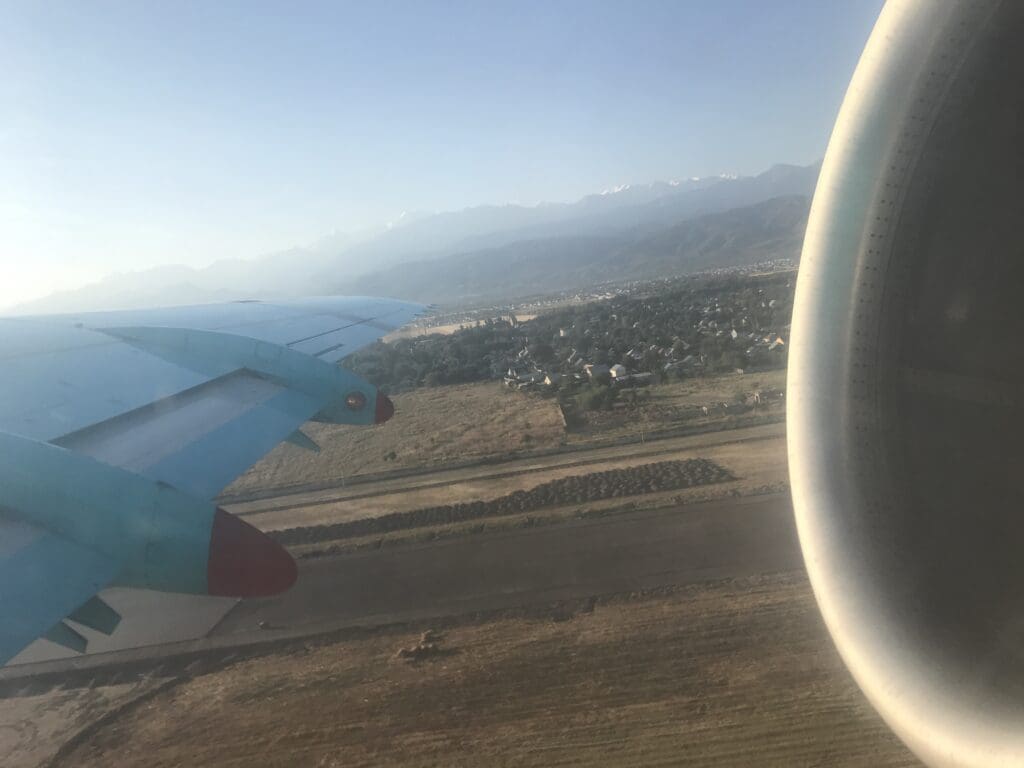
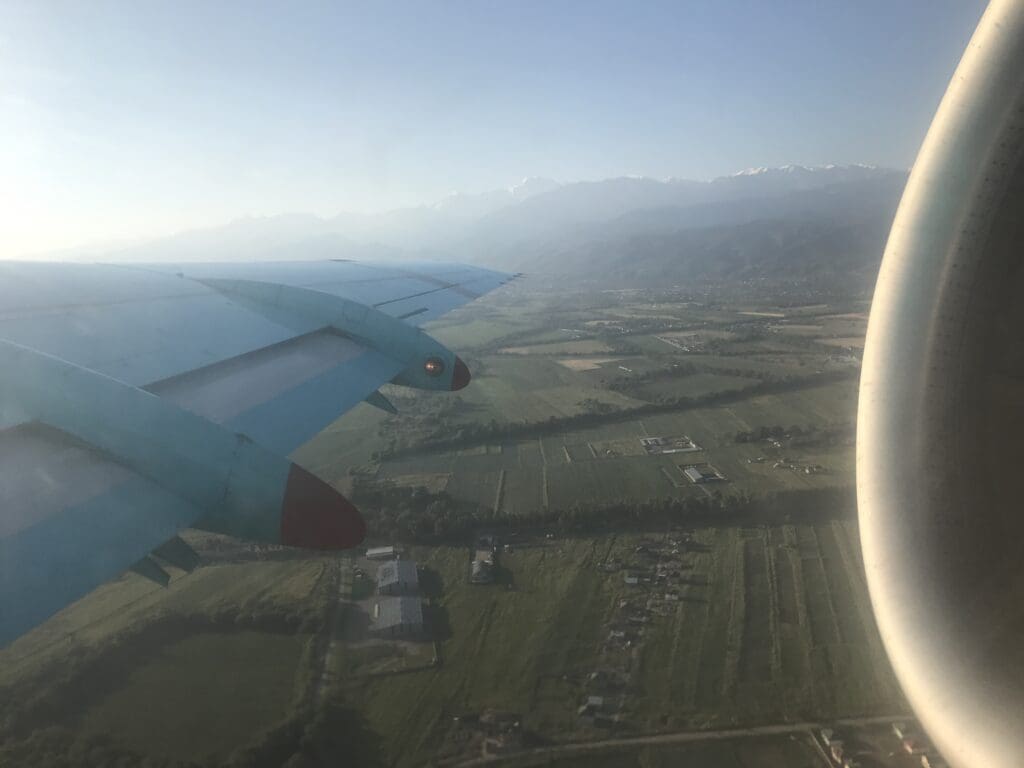
As the aircraft climbed, the morning mist prevented any clear views of the impressive landscape below however basic features of this could still be seen. After climbing out over green fields, six minutes after takeoff, the city of Kapchagay and its large reservoir came into view as we left the mountains of Almaty behind. Around twenty minutes after we departed from Almaty, the Fokker reached its cruising altitude of 34,000 feet at which point the seatbelt signs were extinguished and a significant queue of passengers formed in the aisle waiting to use the rear lavatory.
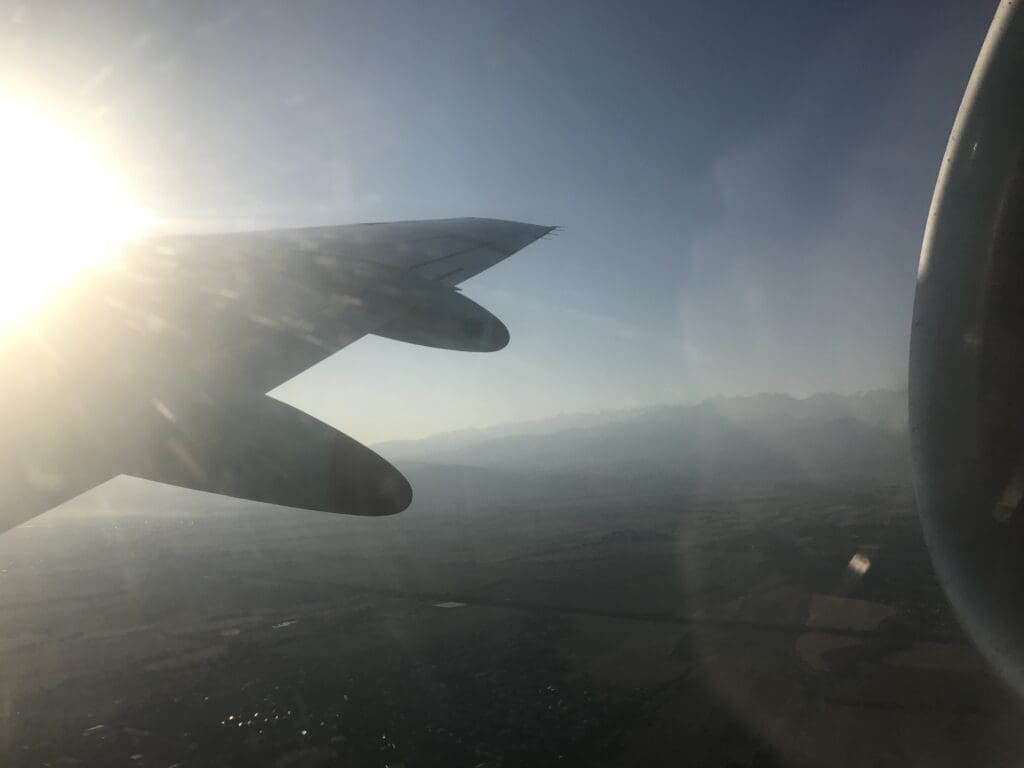
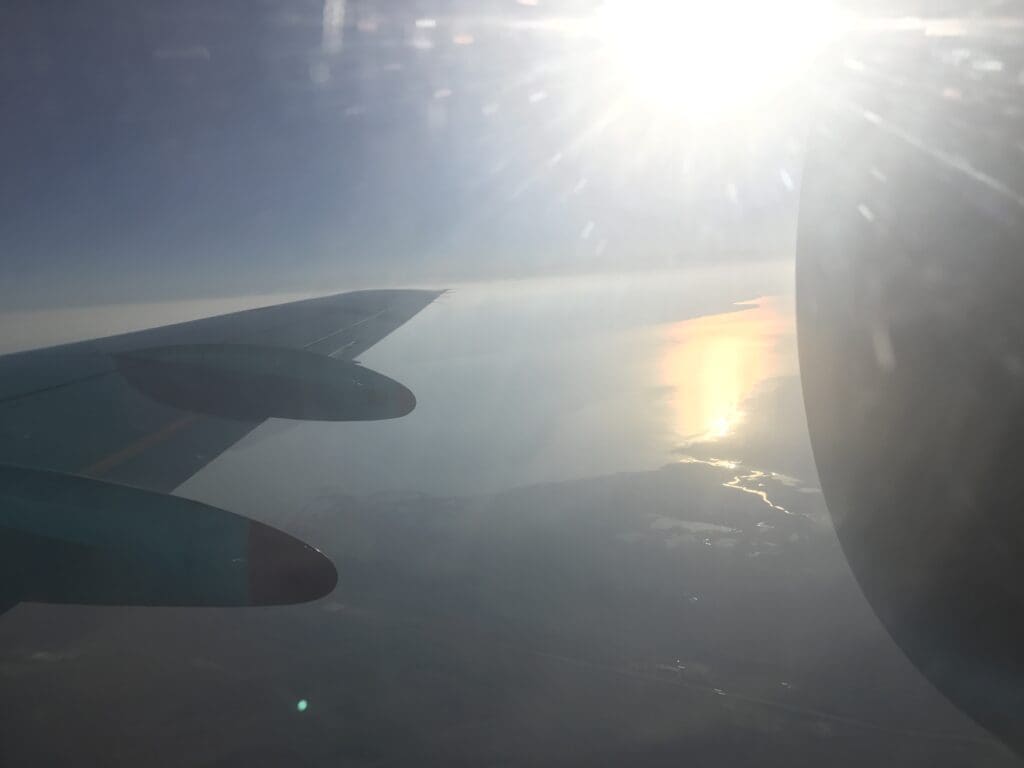
Immediately after the seat belt signs were extinguished, all three flight attendants sprang into action and the snack service commenced. Seeing as the service carts were rolled out from the rear galley, I ended up being served in no time at all. Despite Bek Air’s official status as a low-cost carrier, all passengers were offered a selection of snacks, and soon, a slightly cool flight attendant handed me a large bag of fish-shaped crackers and a chocolate wafer, before requesting my choice of soft drink which was cautiously poured before being handed over to me. This also came with a serviette and a Bek Air branded wet wipe. Beating the offering I had been served on both Qazaq Air and SCAT Airlines’ domestic services, I was left with absolutely no complaints about this service.
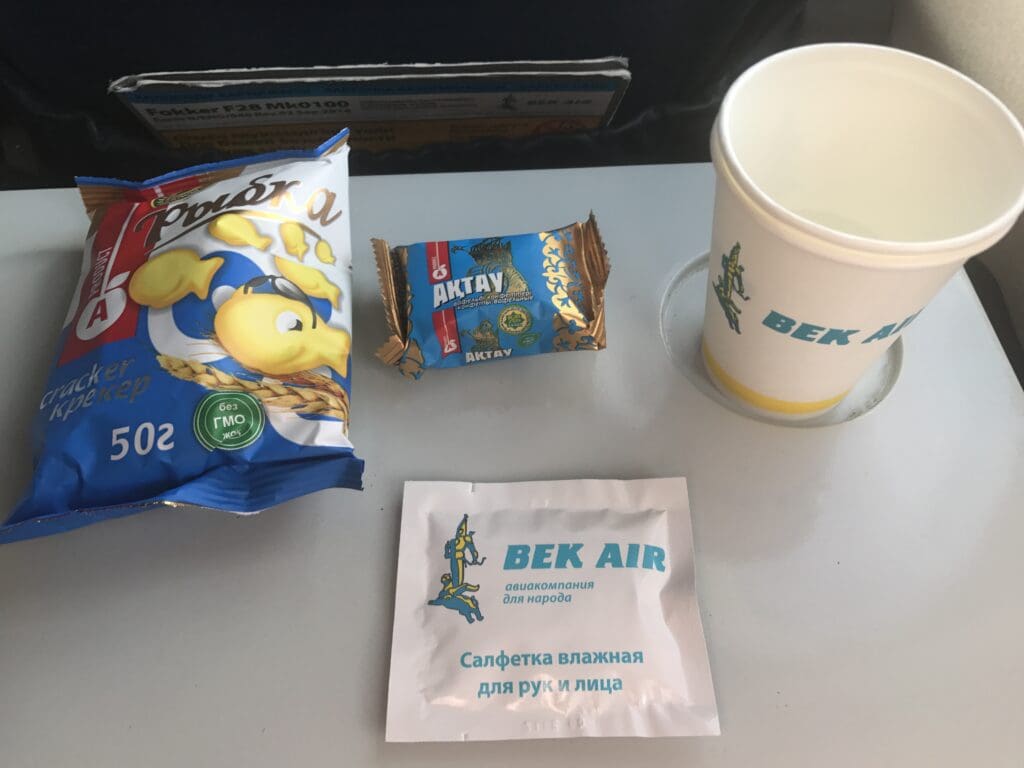
As I chowed down on the snacks, the Fokker passed high above the turquoise waters of the world’s fifteenth-largest lake, Lake Balkhash. Taking several minutes to cross this, soon, eventually, the aircraft made landfall near the city of Balkhash, whose airport I had visited several days earlier, and headed northwards through the skies of Karagandy Province. Once over land, the aircraft appeared to fly parallel with Kazakhstan’s M-36 motorway which stretches over 2,000 kilometres, running from Almaty to the Russian border near Kostanay. Unfortunately, only a short time later, the skies beneath the aircraft became completely covered in clouds, blocking any views of the steppe below. With little to see outside, and no inflight entertainment provided, as we cruised north there was little to do except soak up the atmosphere of Fokker 100, a type that I was unlikely to sample easily back home in Europe.
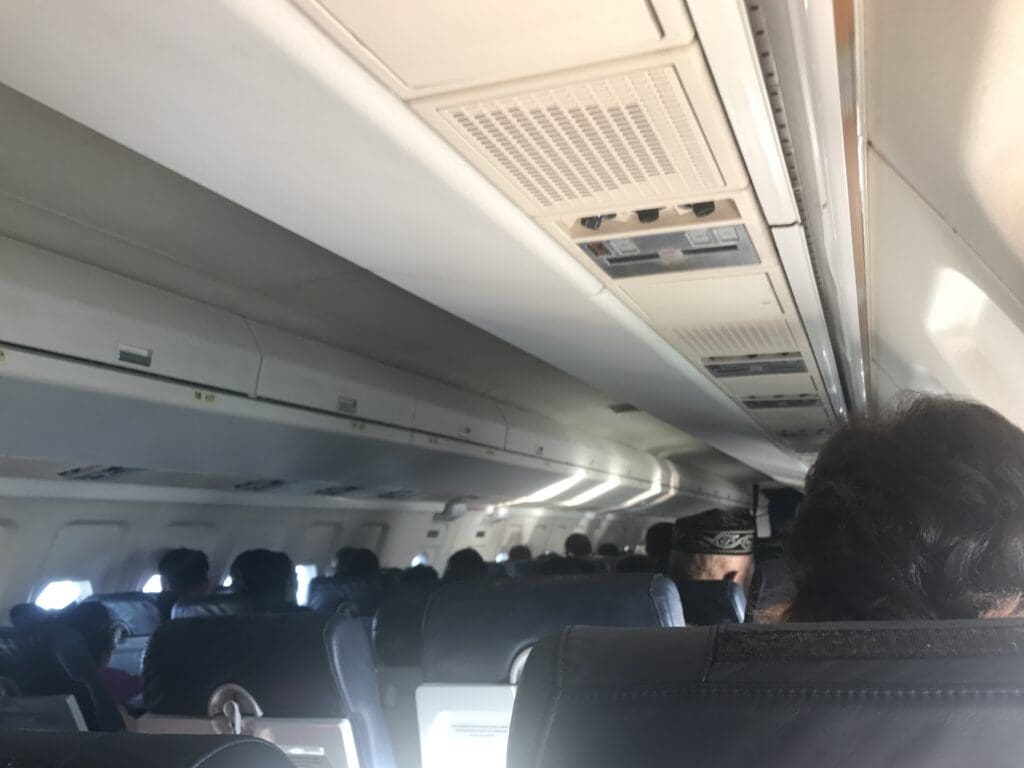


As the aircraft continued onwards towards Almaty, at 0800 all three crew members passed through the cabin with large black bin bags, encouraging passengers to part with any rubbish that they had accumulated during the flight. At 0813, the aircraft’s seatbelt signs were reilluminated before the Purser performed a trilingual announcement which featured all the usual warnings and instructions regarding seatbelts, tray tables, window shades and seatbacks, and a short time later several flight attendants passed through the cabin ensuring all was secure and in place for our arrival.
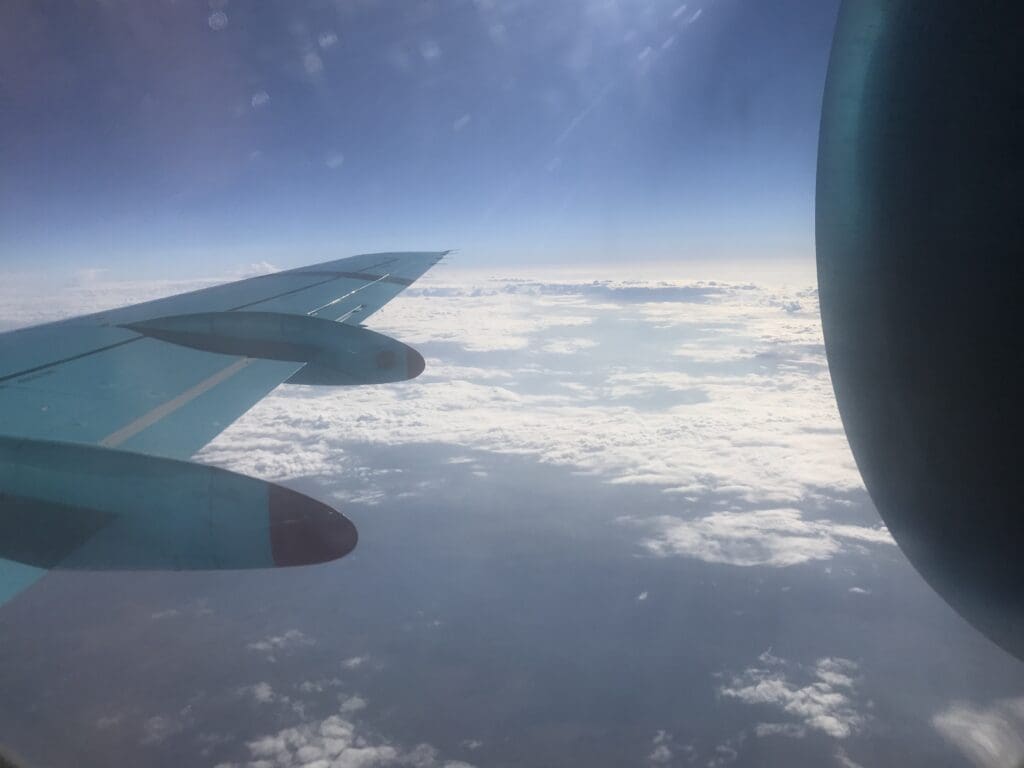
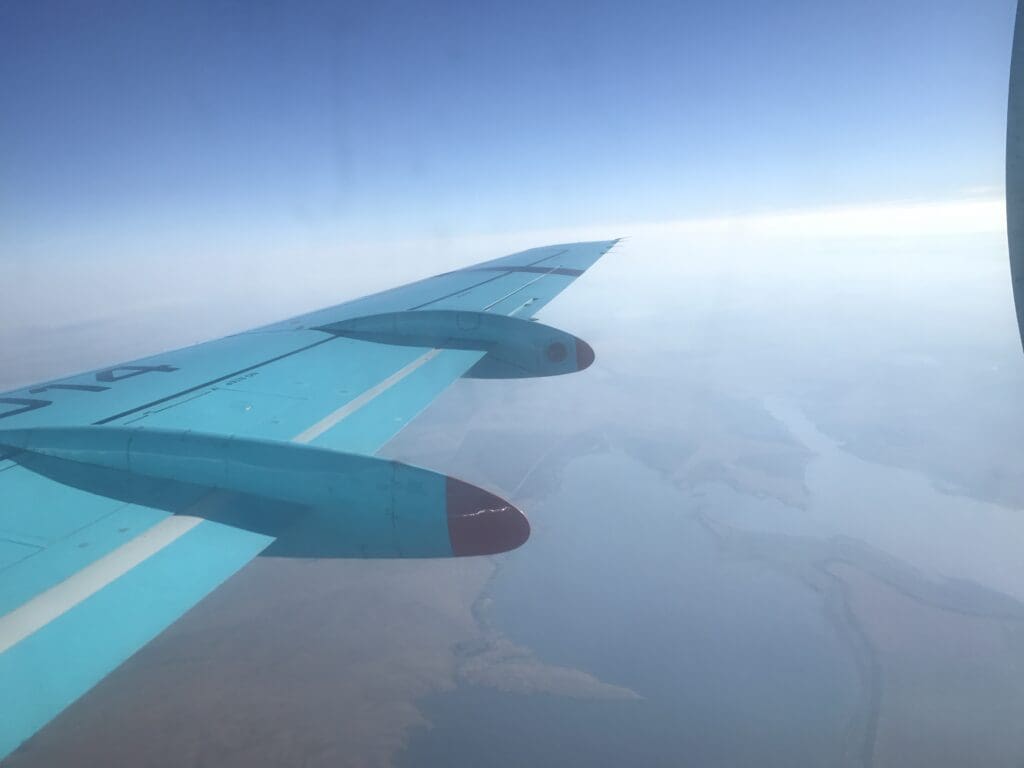
Soon enough, the aircraft sank into the bumpy clouds and, upon emerging beneath these, the sight of a winding river to the north of the city of Termitau could be seen. Several minutes later, my attention was turned away from the views of the Kazakh steppe outside, as inside the aircraft, some commotion erupted at the rear of the cabin. Following some shouting, several passengers rushed to the rear of the aircraft where it appeared that an elderly passenger had fainted. Once the crew became aware of the situation, a cup of water was passed to the passenger, who fortunately came around within a few moments and was placed back in their seat.
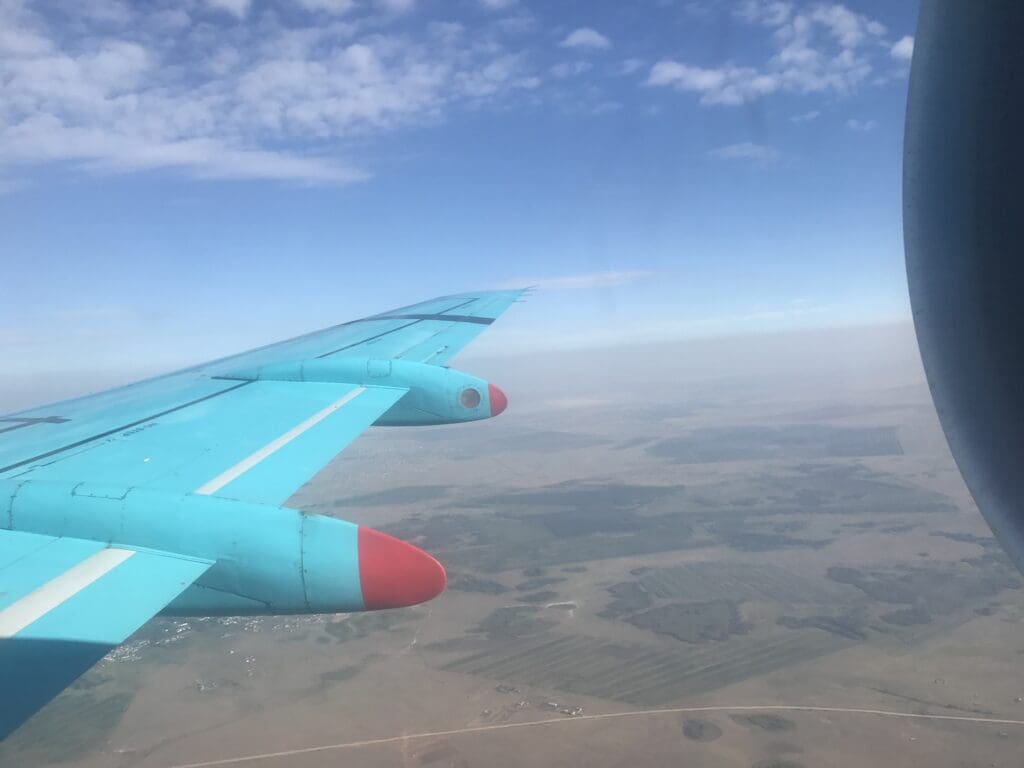
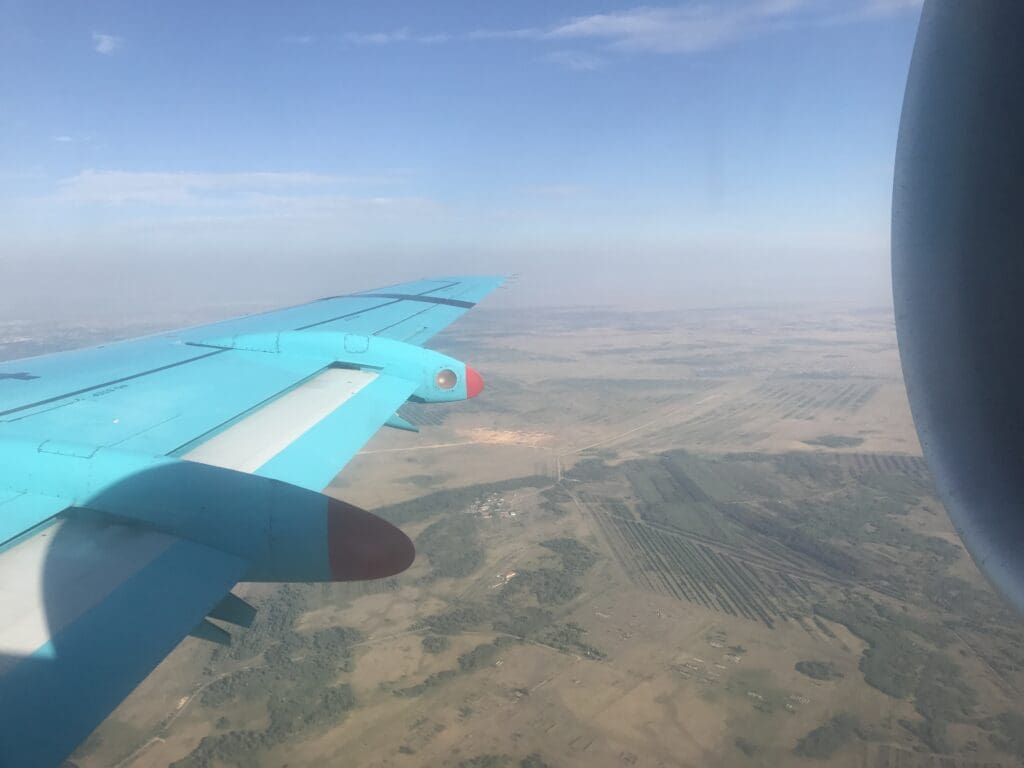
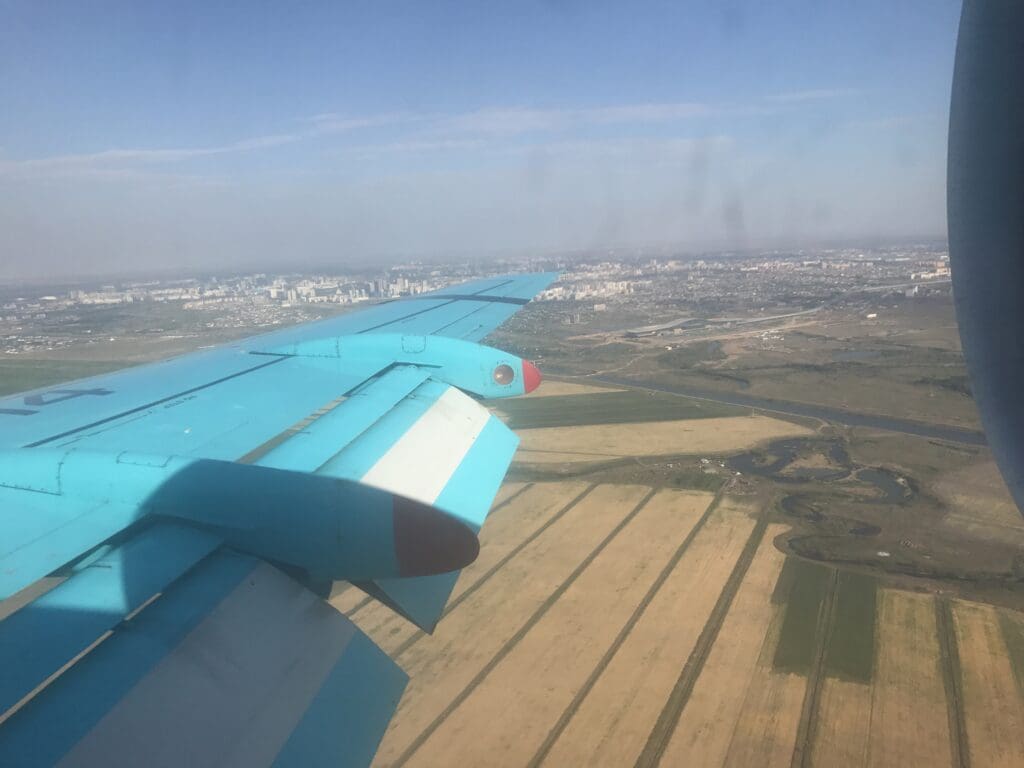
With the drama over, the aircraft continued its descent over the dusty landscape which became slightly greener as we approached the capital. Highlighting Astana’s planned nature, the landscape below suddenly transformed from countryside to urban sprawl at which point the flaps and gear were extended in preparation for our arrival. As the Fokker neared the airport, Astana’s city centre came into view, where a reasonable view of the city’s sights could be had before the aircraft descended over the grassy lands that surround the city before whizzing over the airport’s perimeter fence. Moments before touching down, the aircraft darted past a vintage Zhetsyu Yak-40 that was waiting its turn to depart, with this operating a scheduled service down to Taldykorgan – a small town to the west of Almaty. Whilst this was a flight I had wanted to sample, unfortunately, working this into my schedule and booking this proved to be impossible.
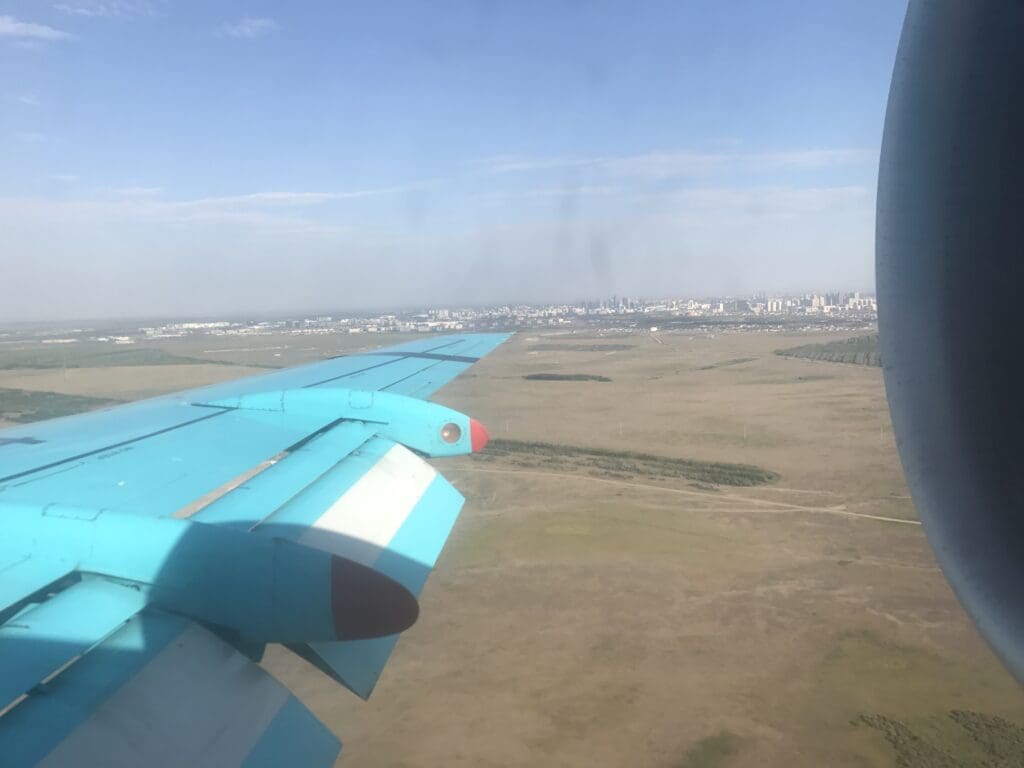
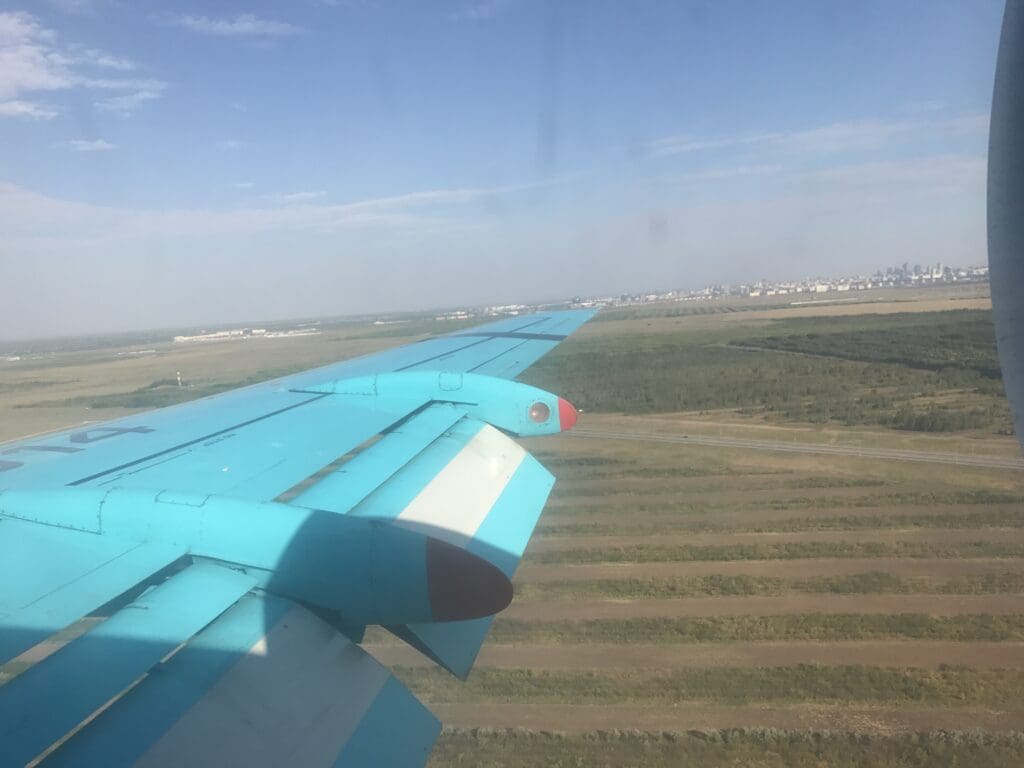
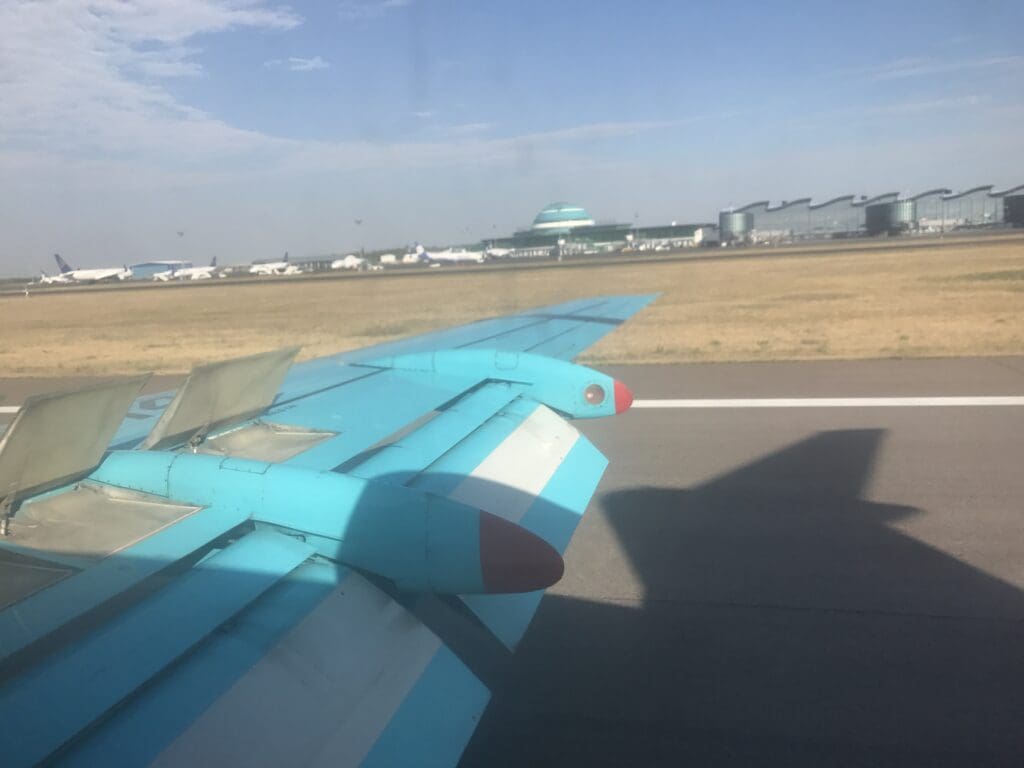
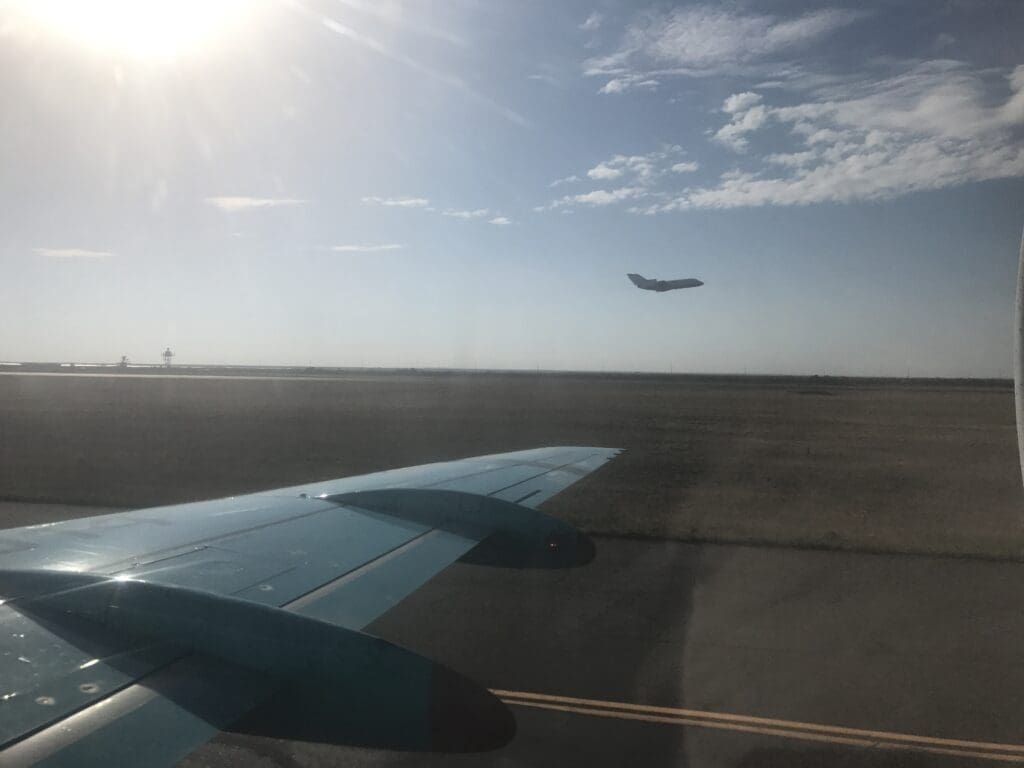
After a pleasant 1H32 in the air, at 0837 the aircraft made what was a rather abrupt touchdown which was then followed by some gentle braking, eventually vacating the runway to the right and making a short taxi to a remote stand. Within minutes of our touchdown, the engines spooled down and the seatbelt signs were extinguished with a loud ding. However, as if often not the case, there was no rush to disembark. After a couple of minutes, the main cabin door opened and passengers began to filter off the aircraft one by one. Eventually, I stood up and headed down the cabin, thanked the crew at the front of the aircraft and cautiously climbed down the aircraft’s steps into the pleasantly warm August Astana air. Seeing as I had been one of the last passengers to disembark the aircraft, within a minute of stepping onto the waiting bus, the doors closed and we headed off towards the terminal. During this short journey across, I failed to spot any particularly interesting aircraft, although that morning Astana appeared to be Embraer 190 central with plenty of examples from Air Astana as well as one from China Southern Airliners, the latter being prepared for its flight back to Urumqi. Once the bus pulled up to the terminal, I disembarked and headed straight into the luggage collection hall. Whilst I was in no rush, I was nevertheless pleased to see that my suitcase was one of the first to enter this, arriving there a few minutes after my arrival, and thus, I was able to walk out of the airport within approximately twenty minutes after touching down.
